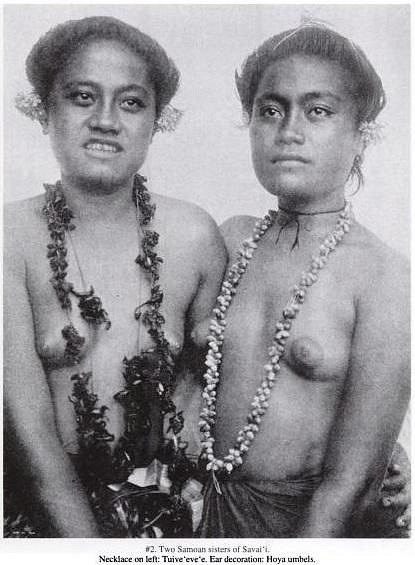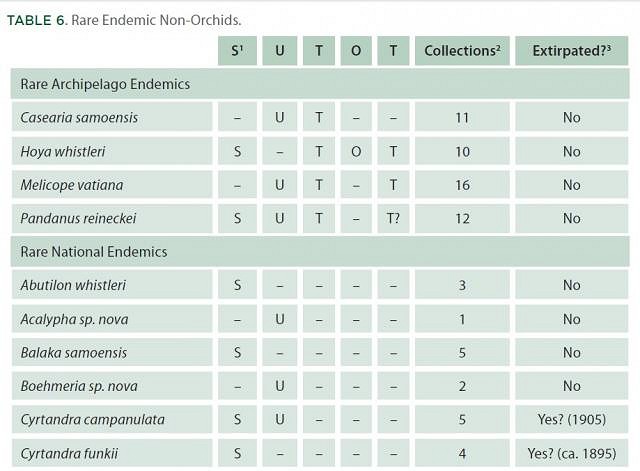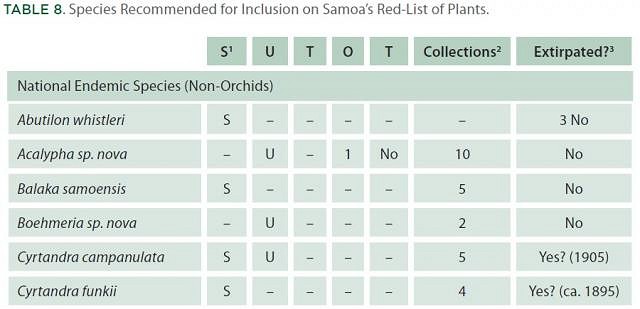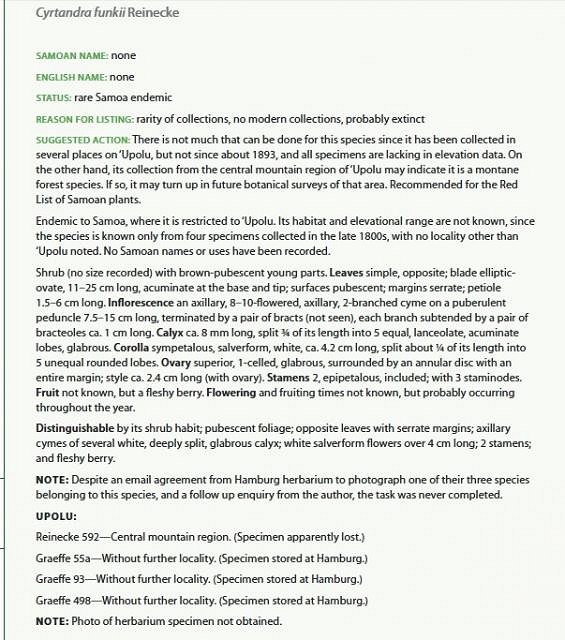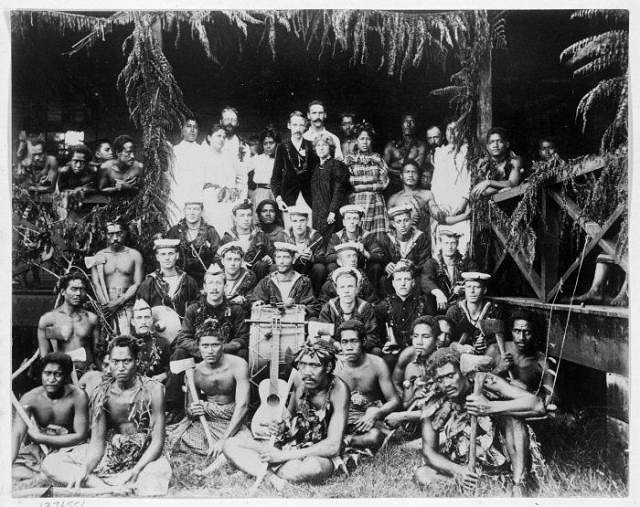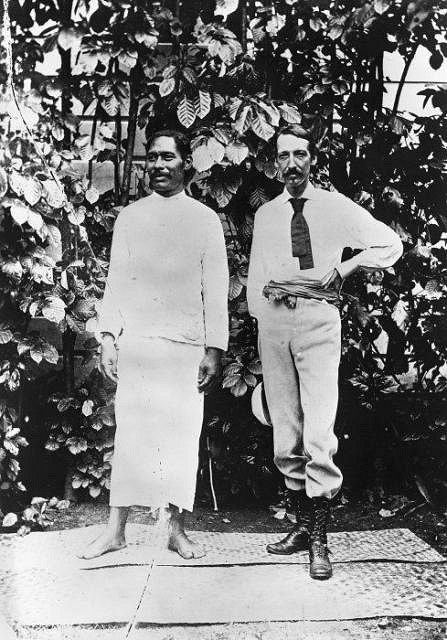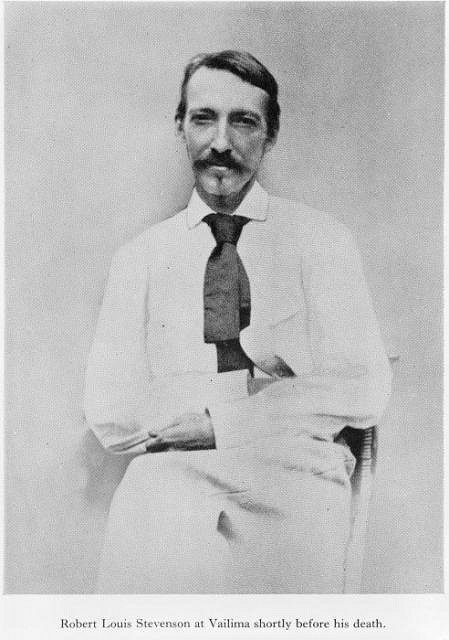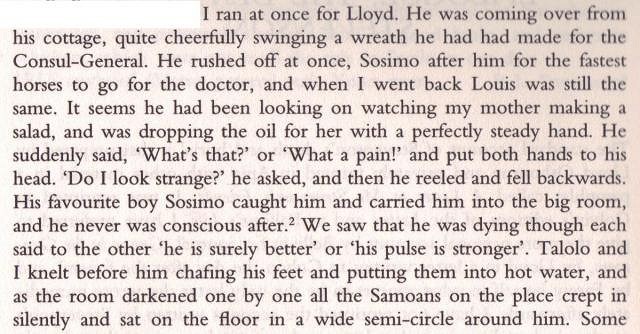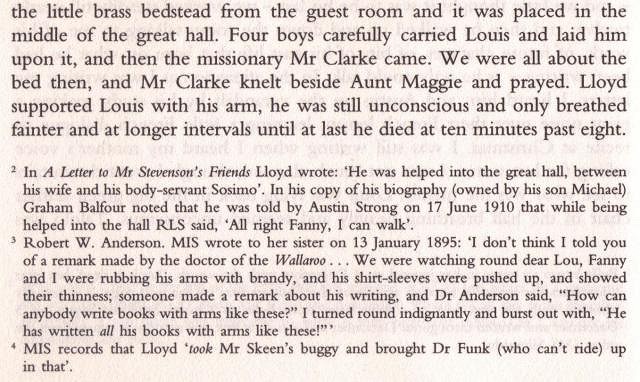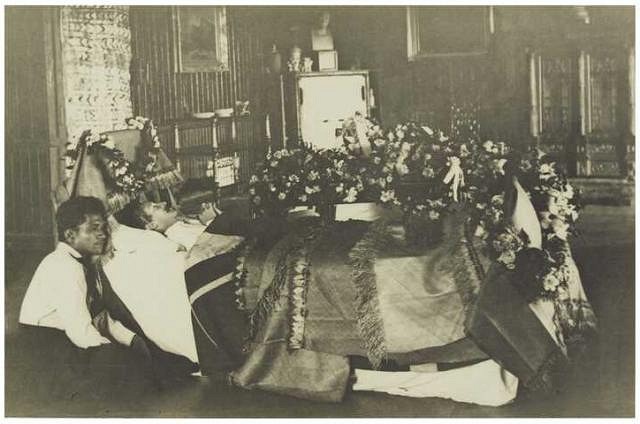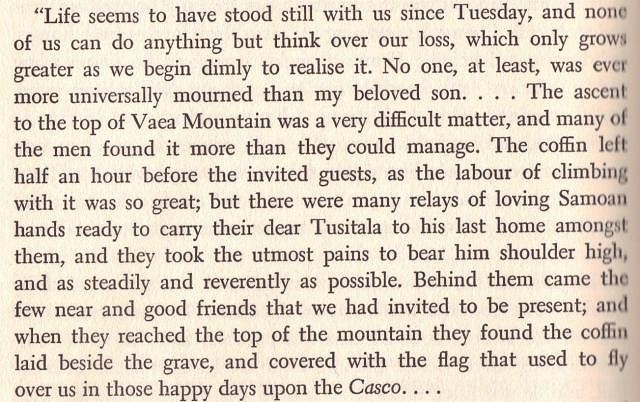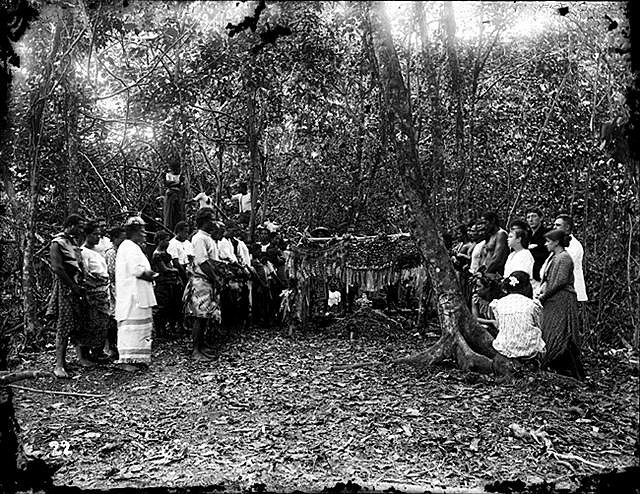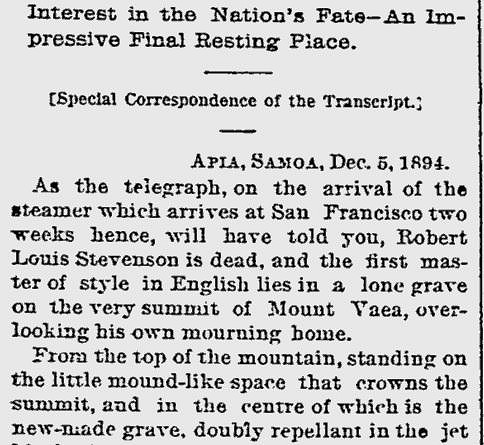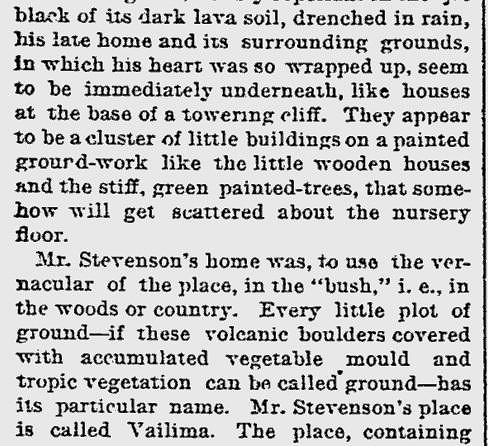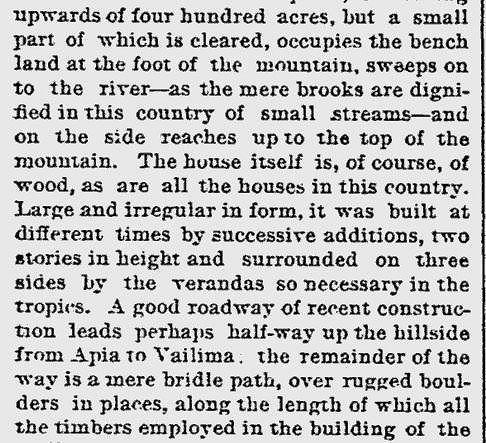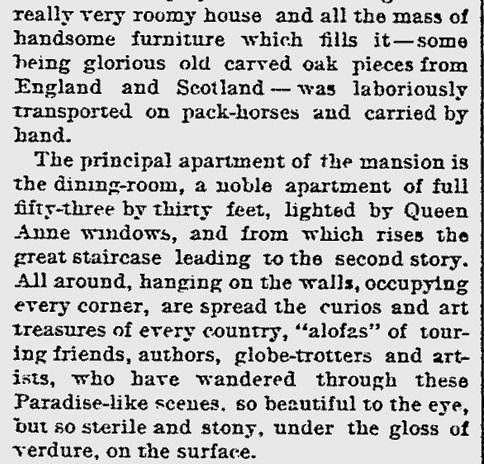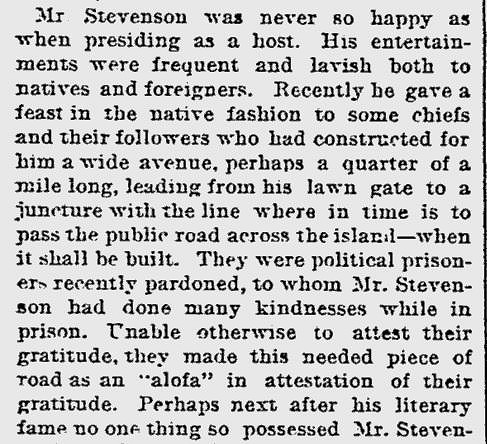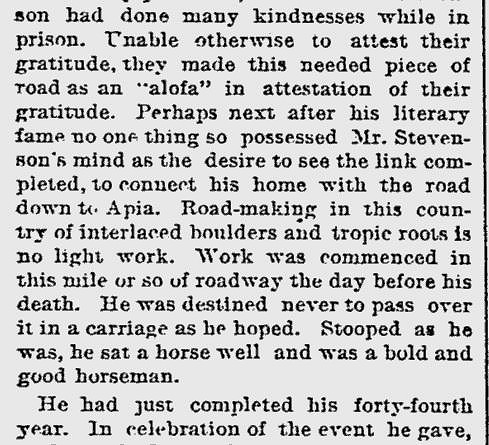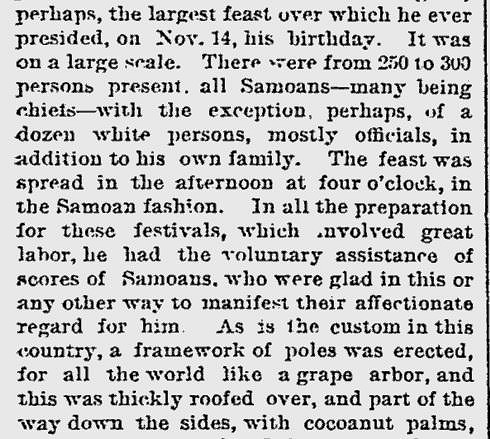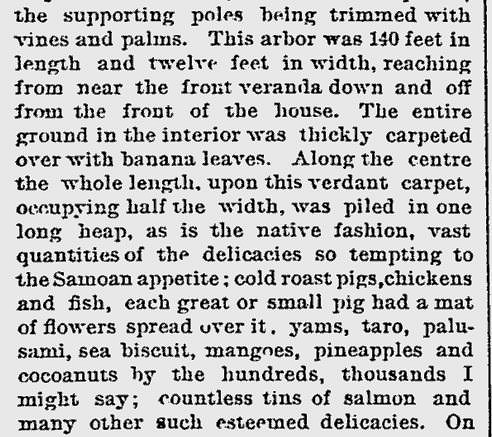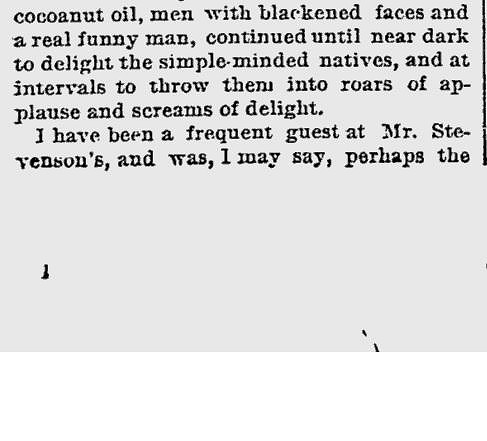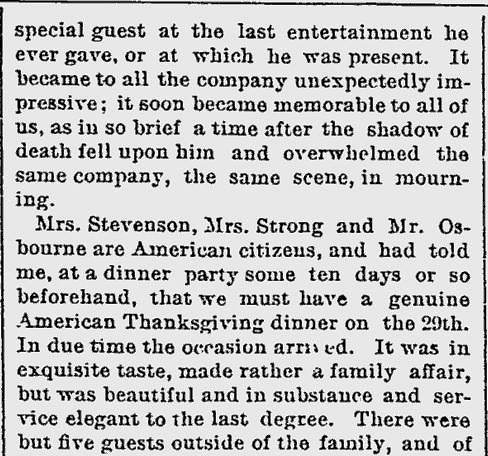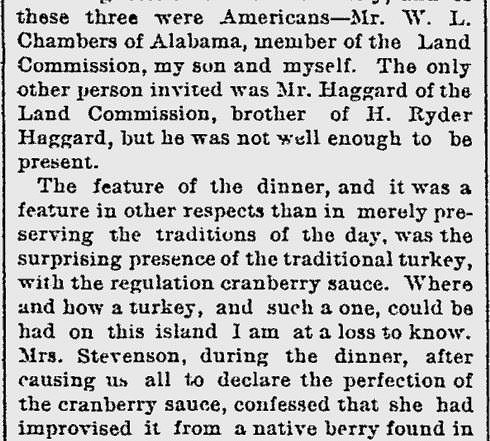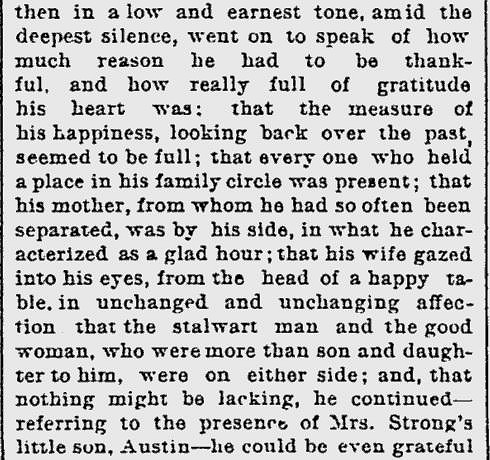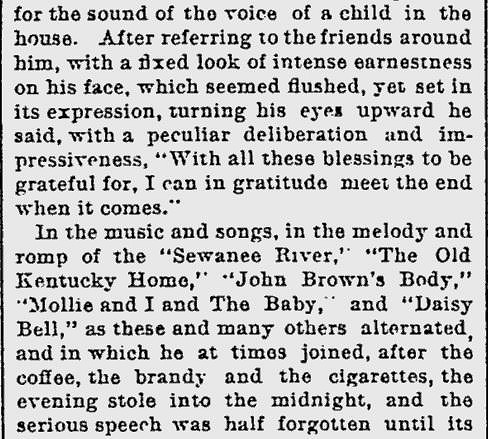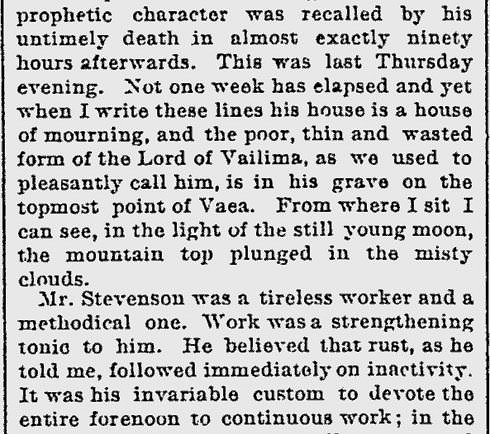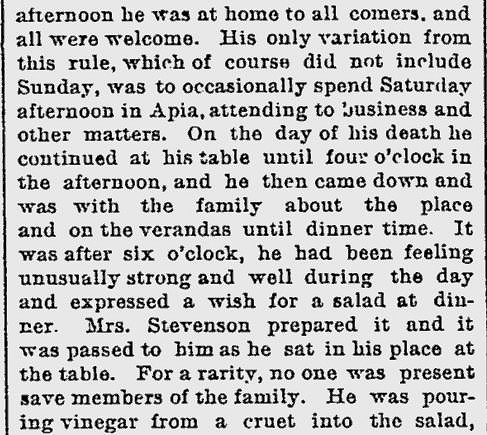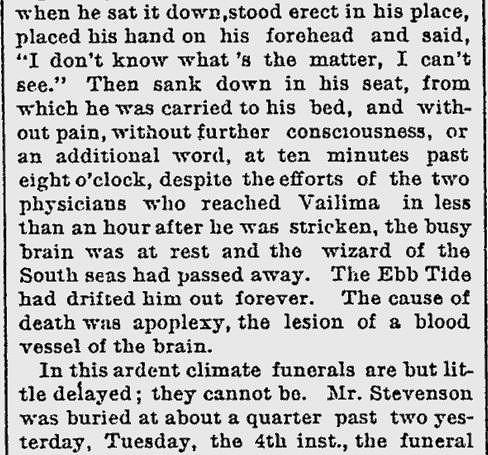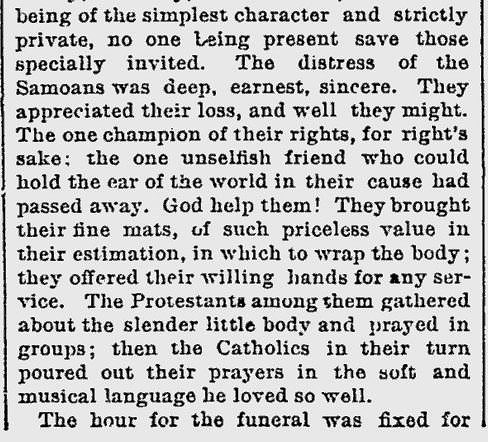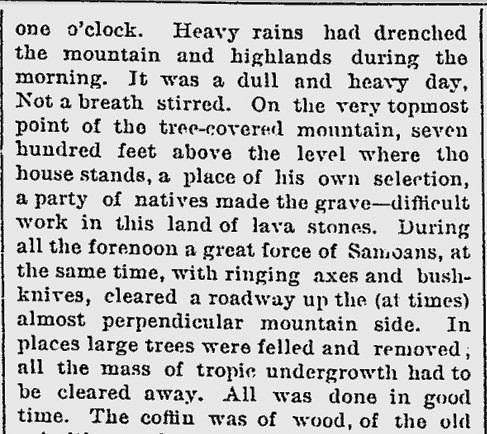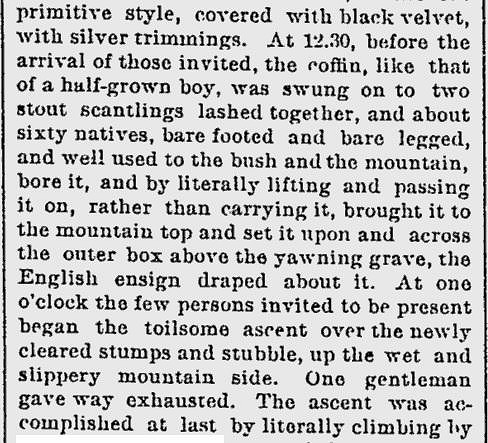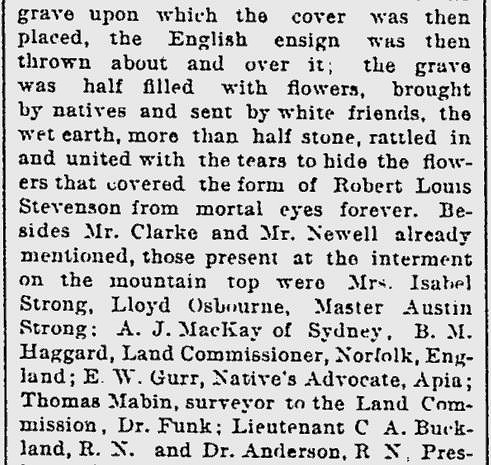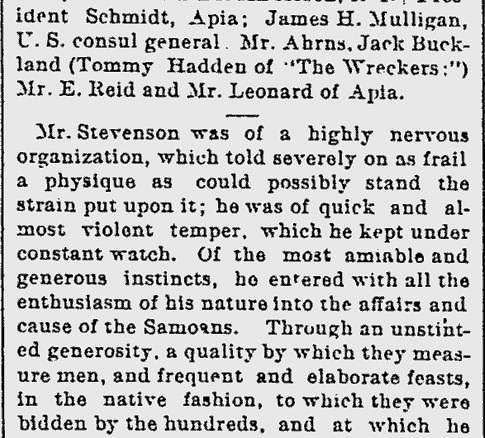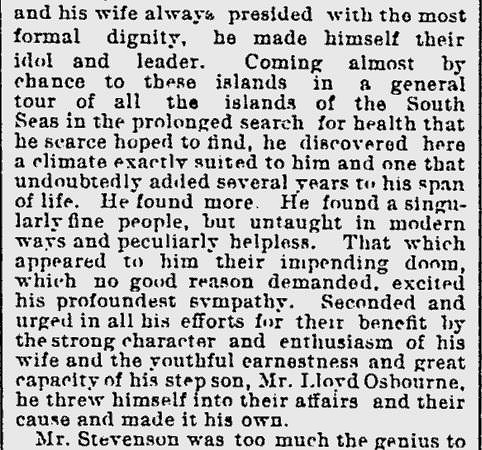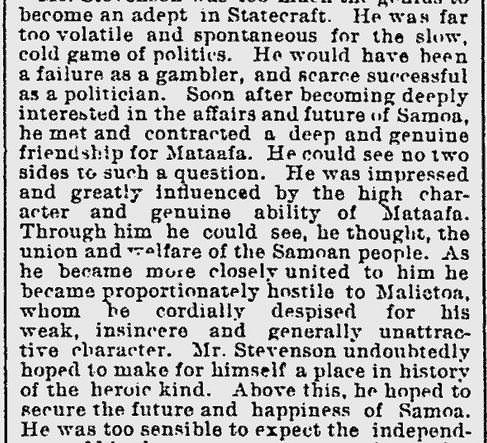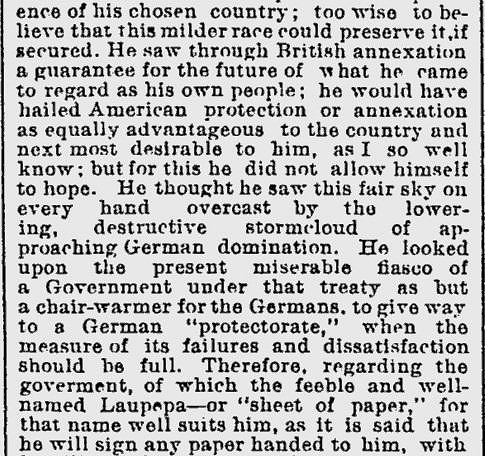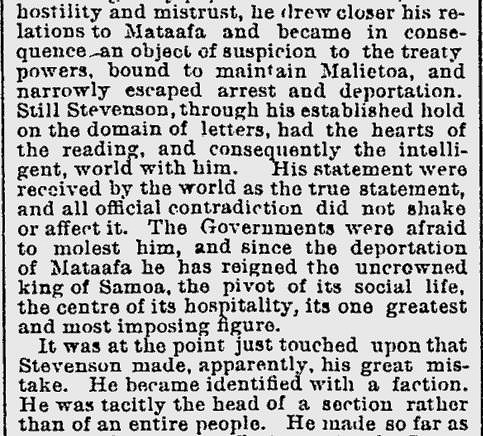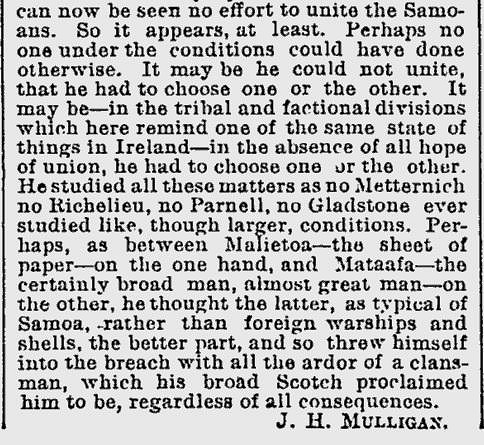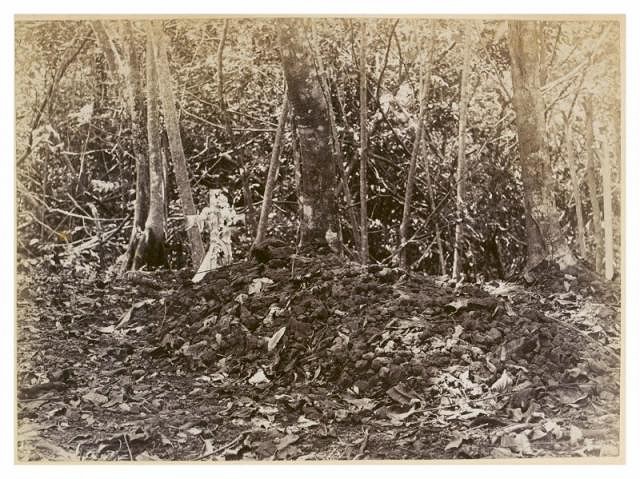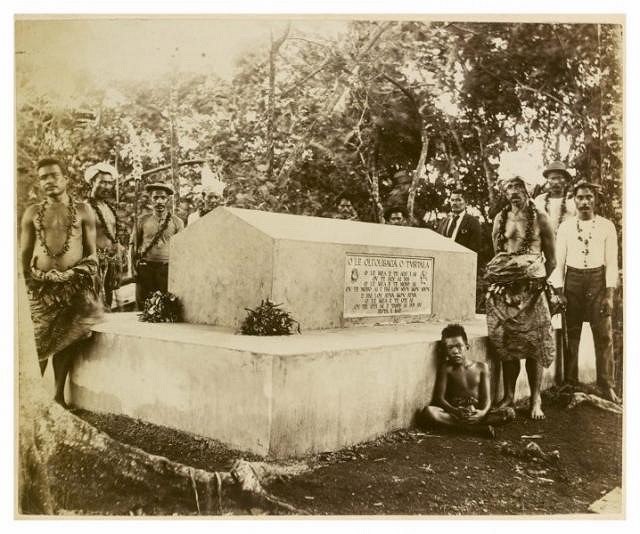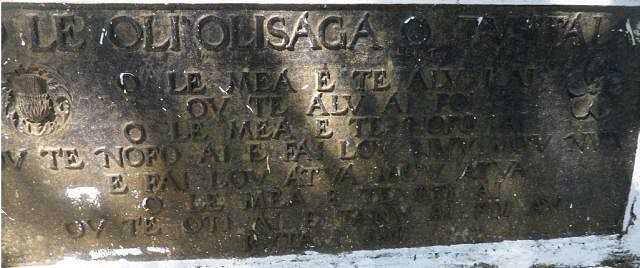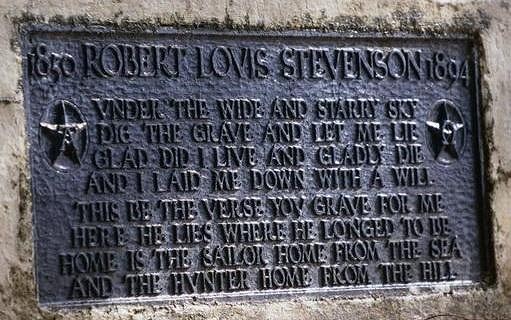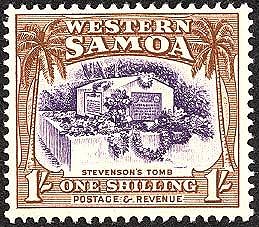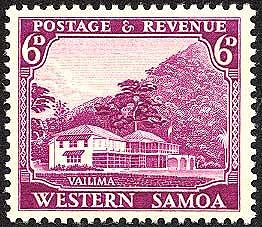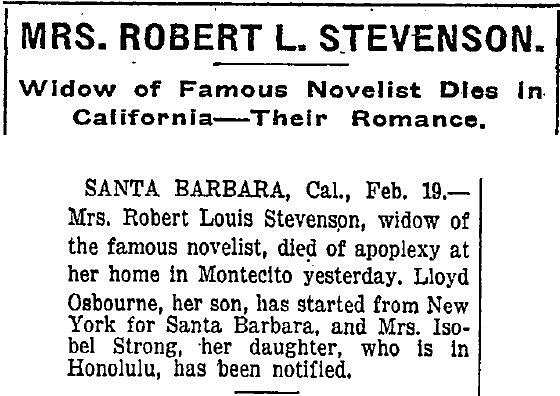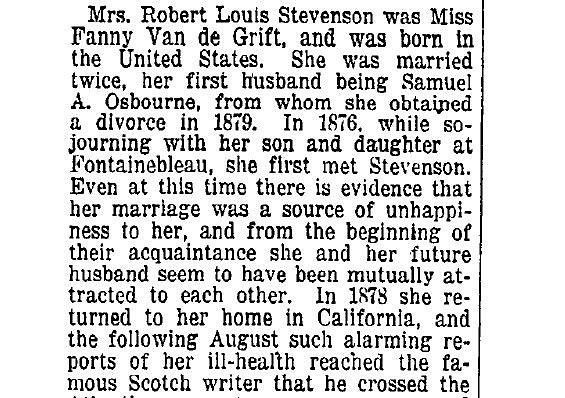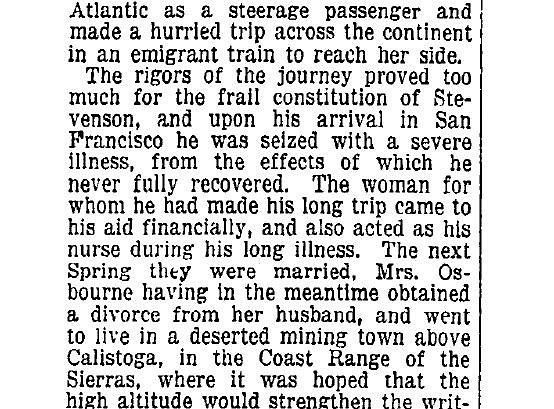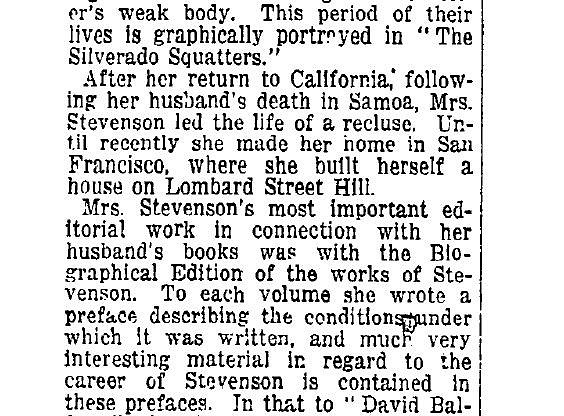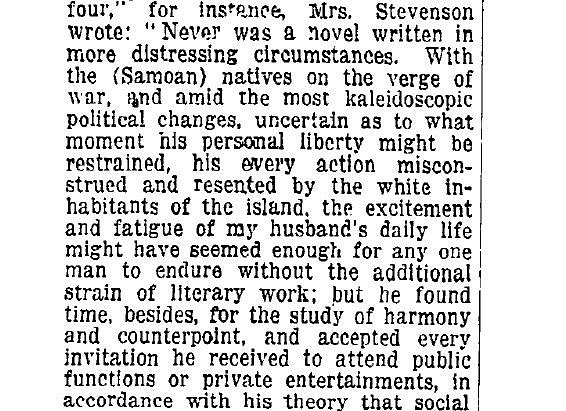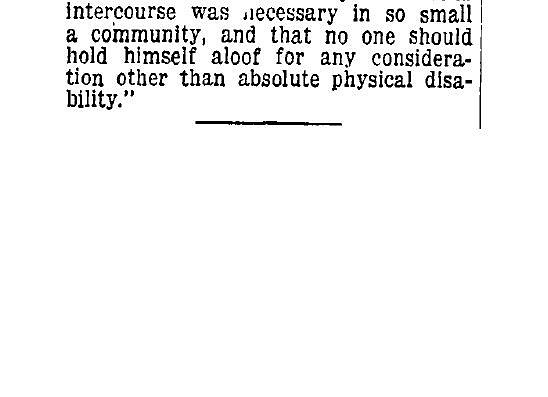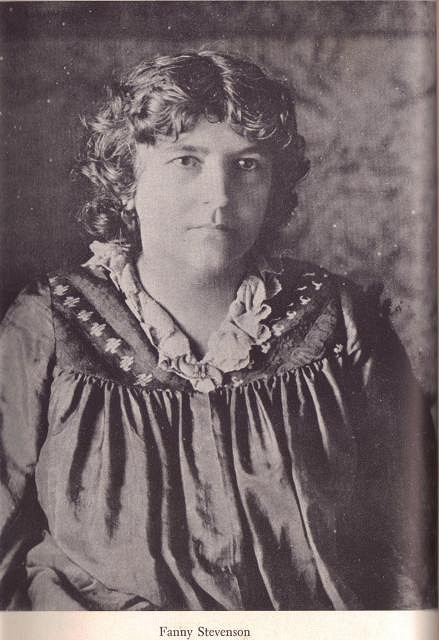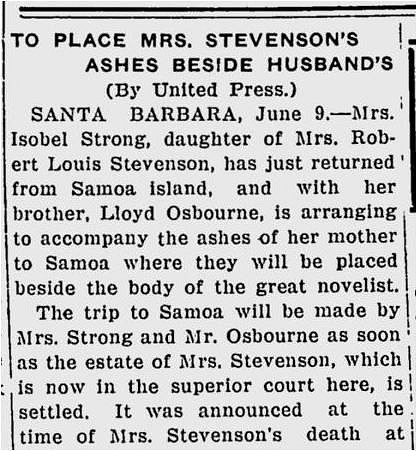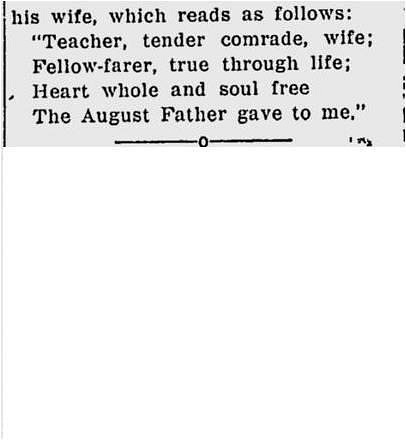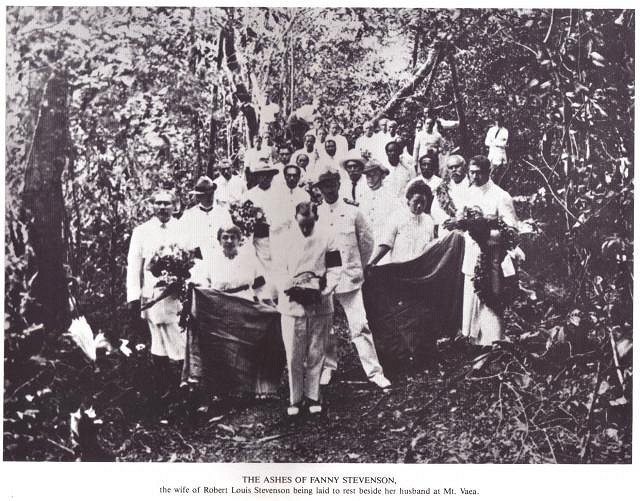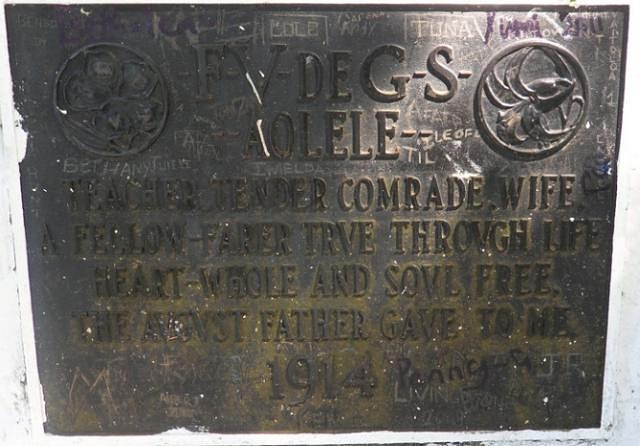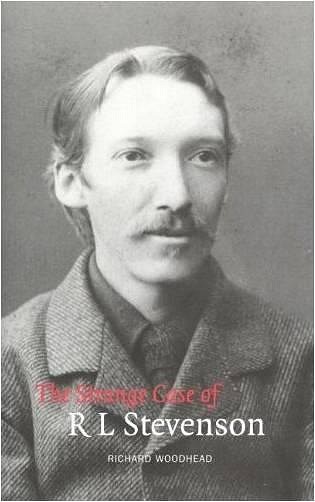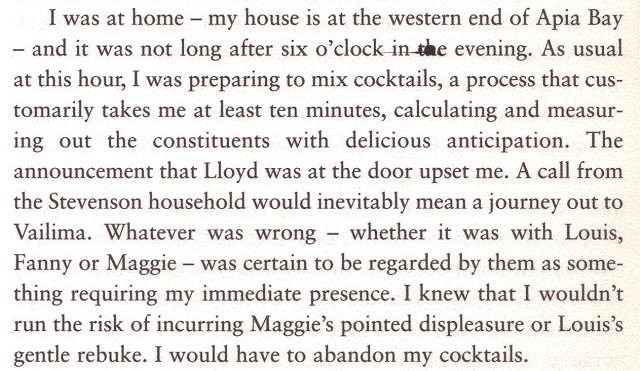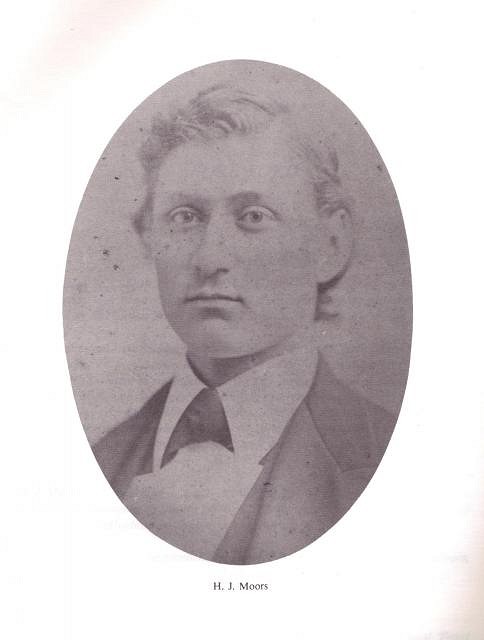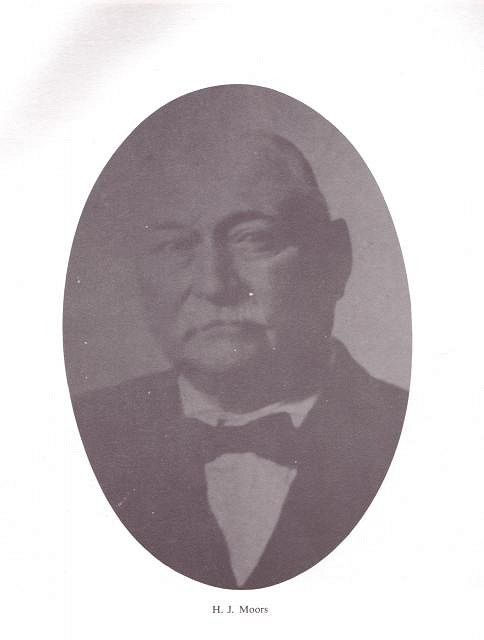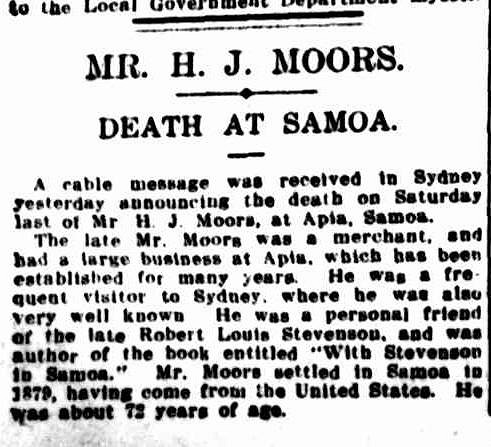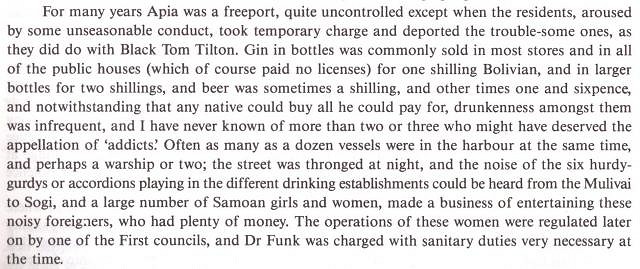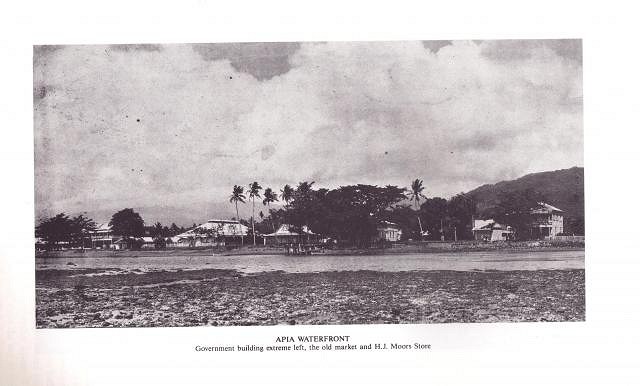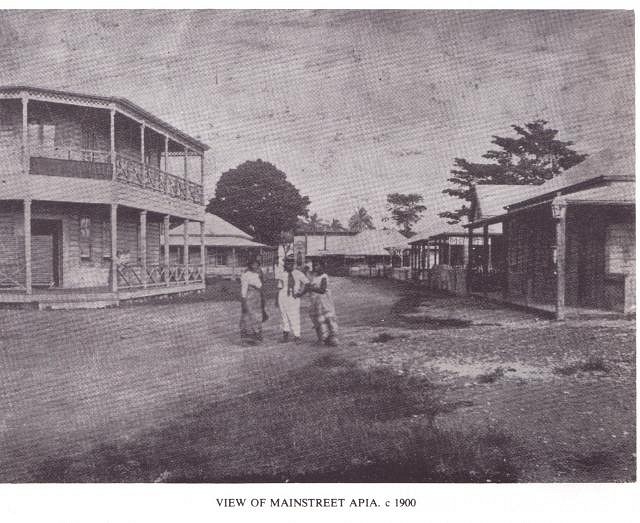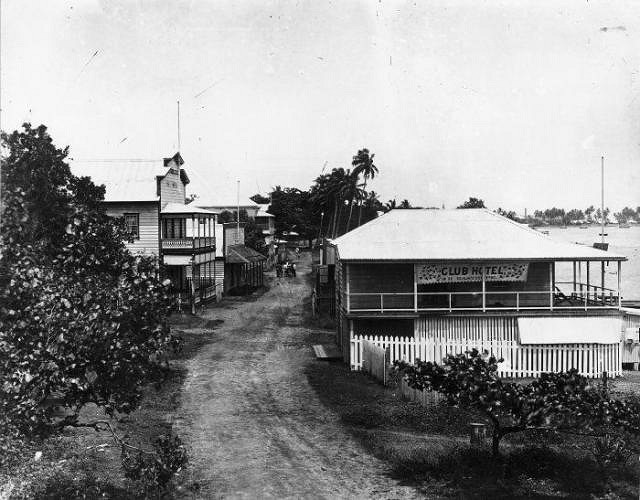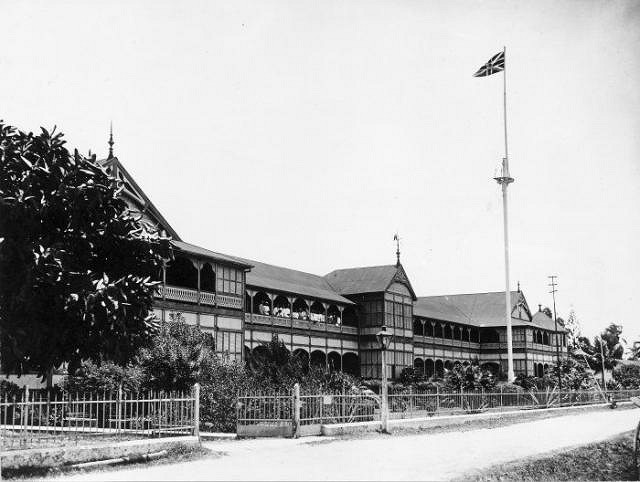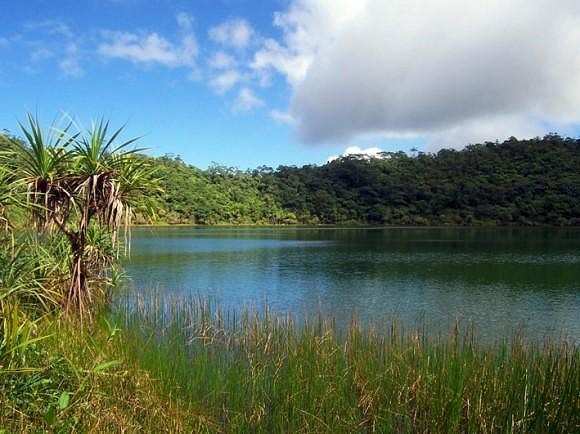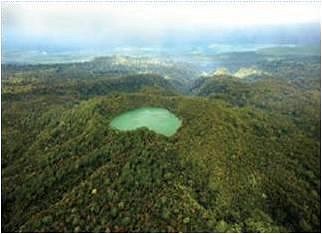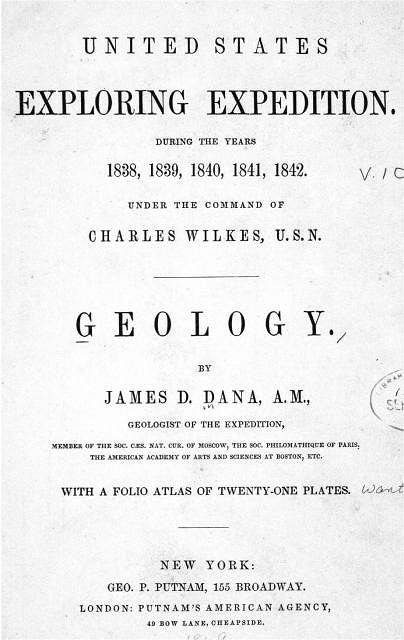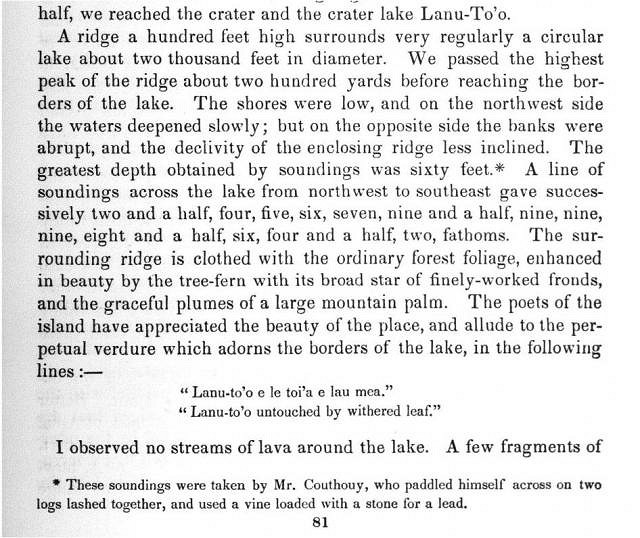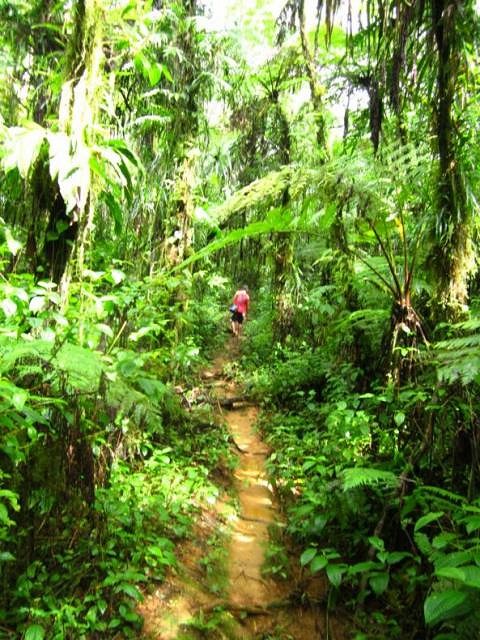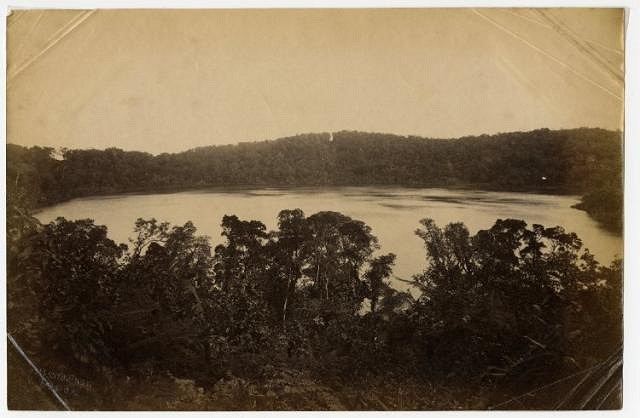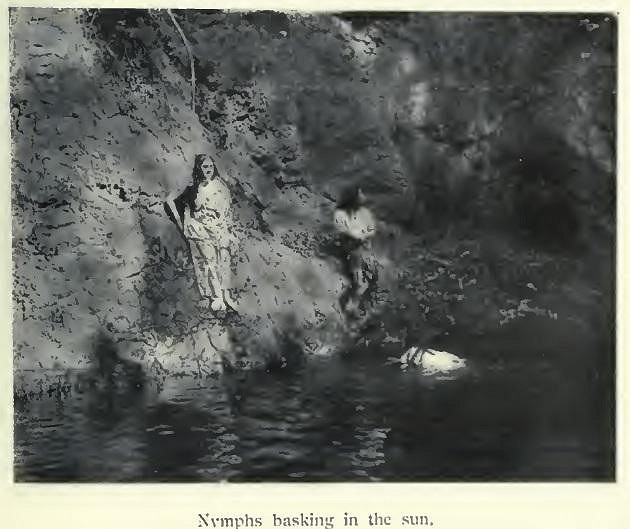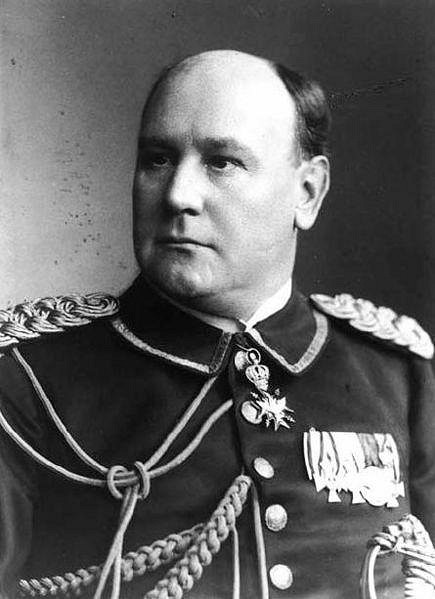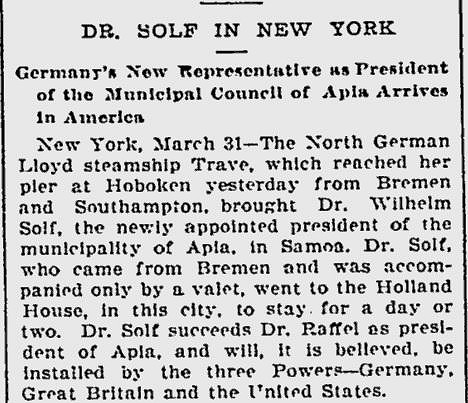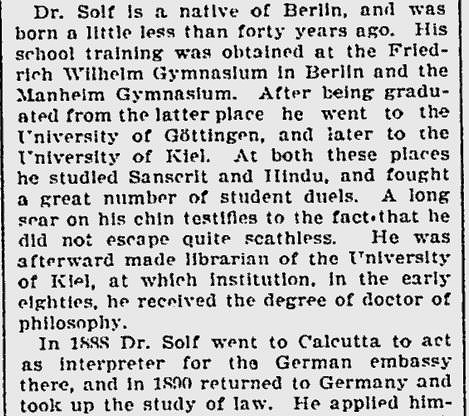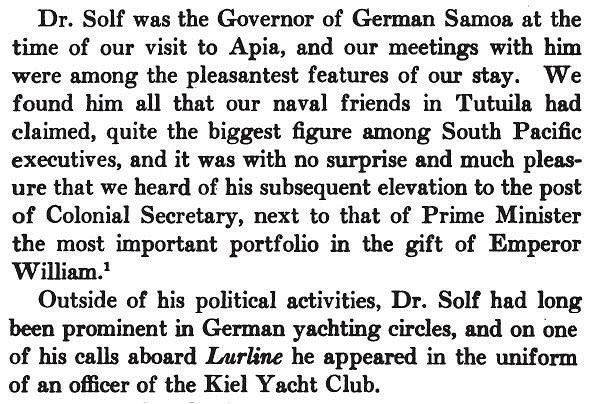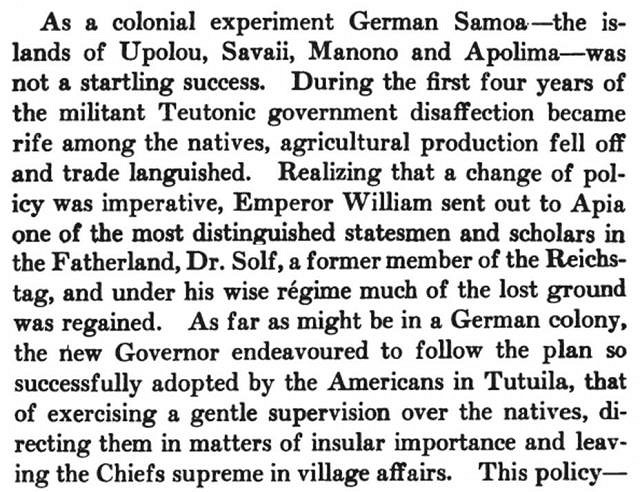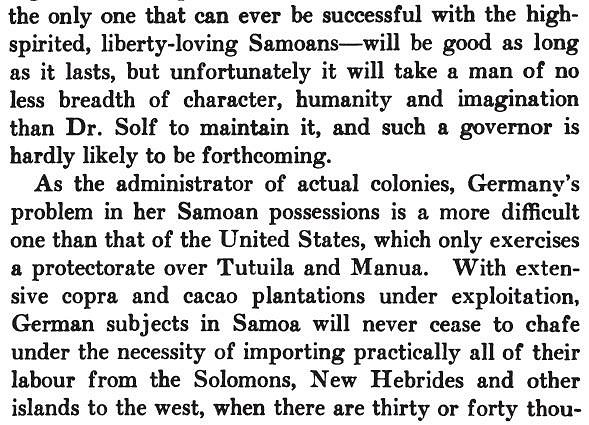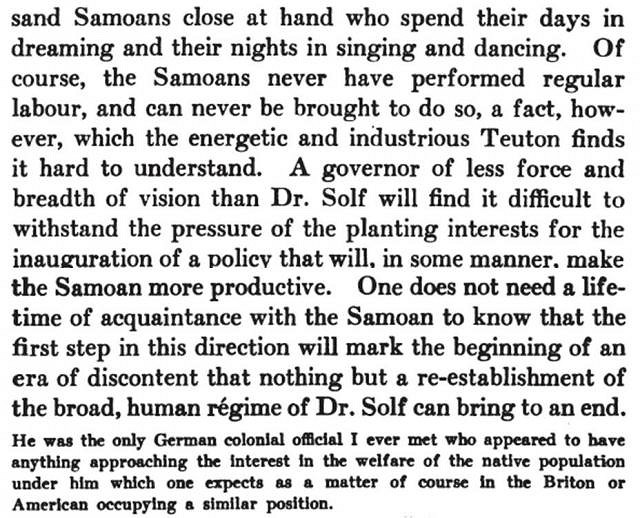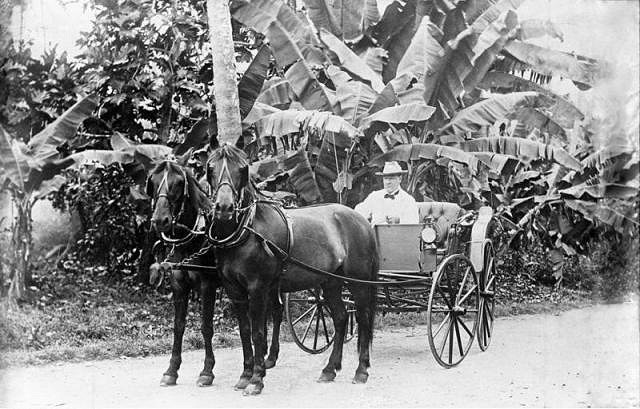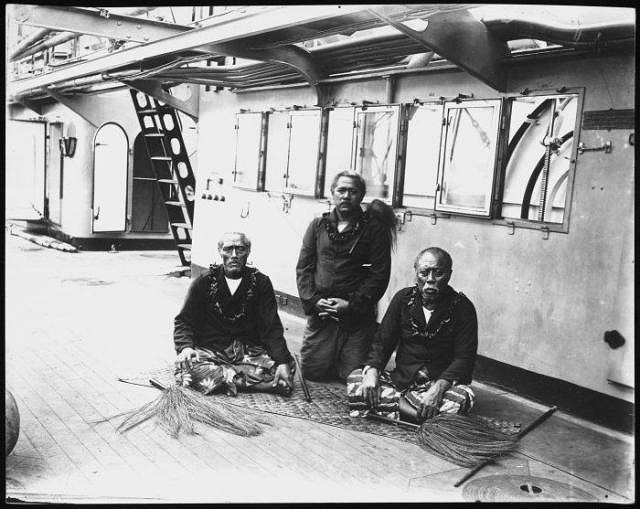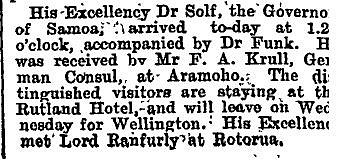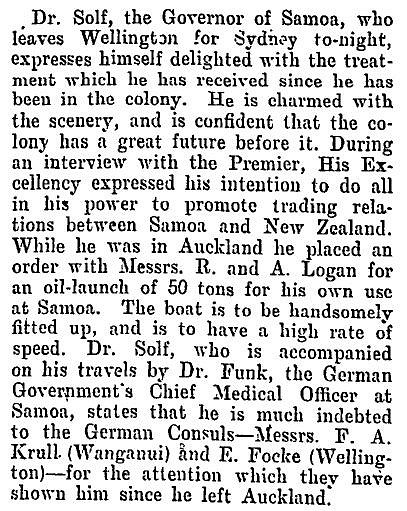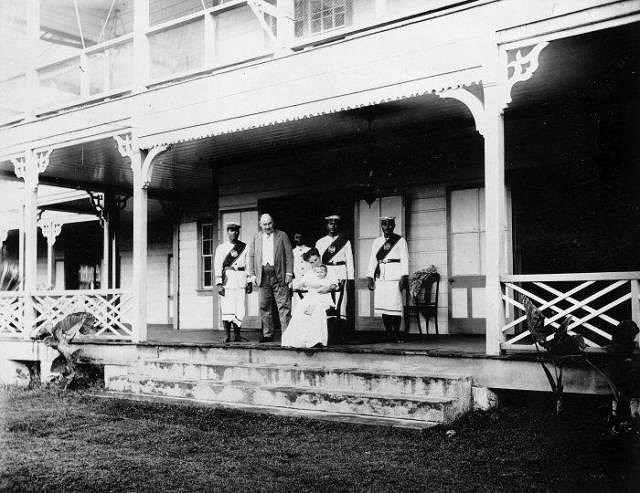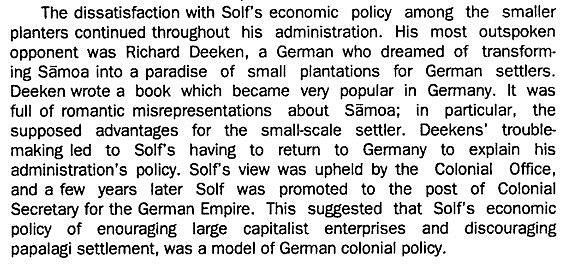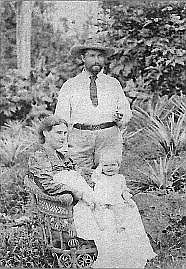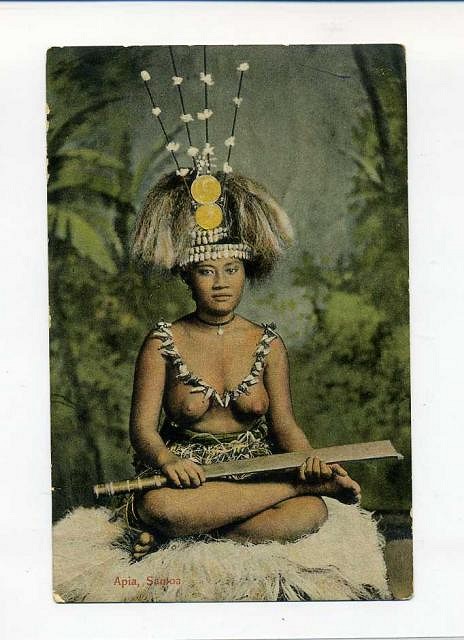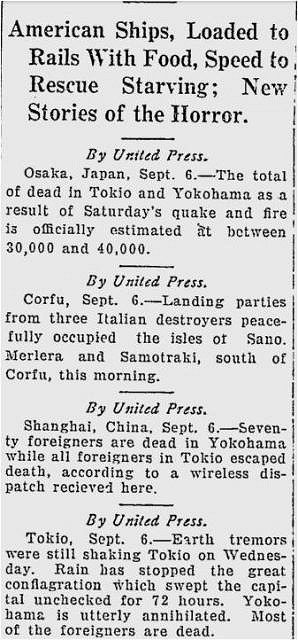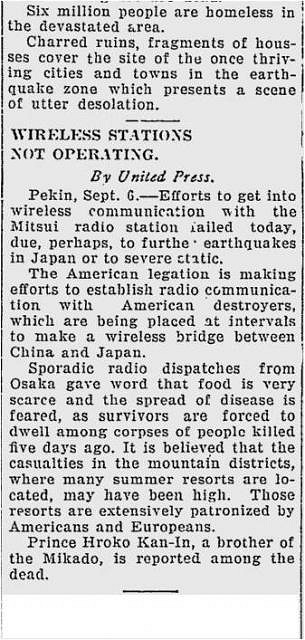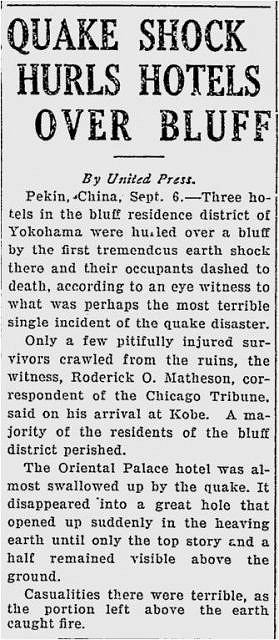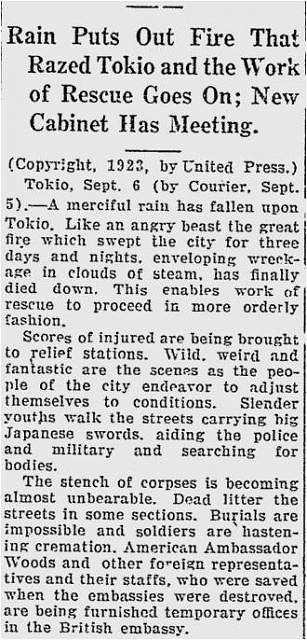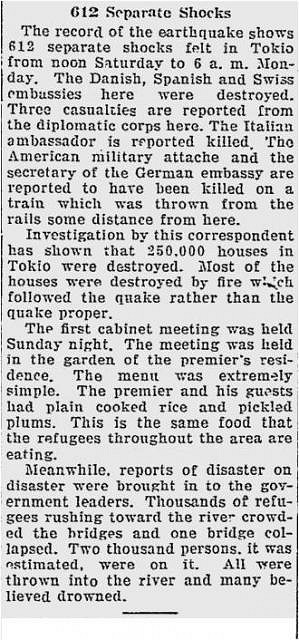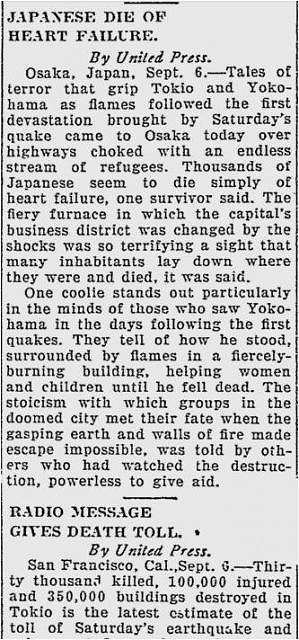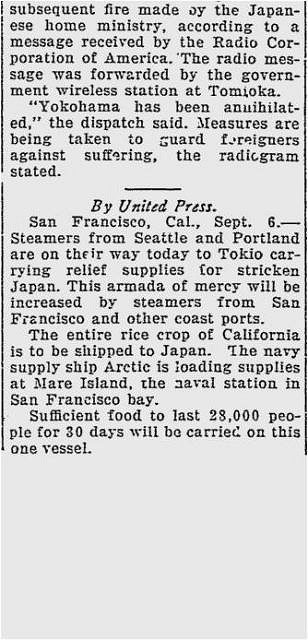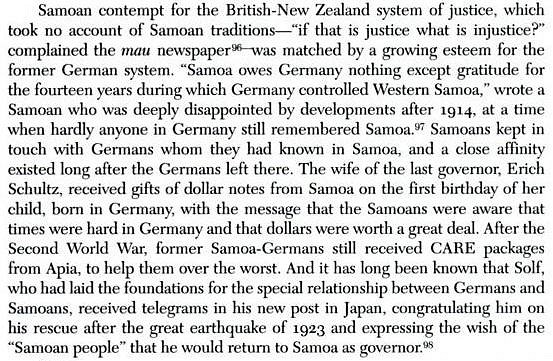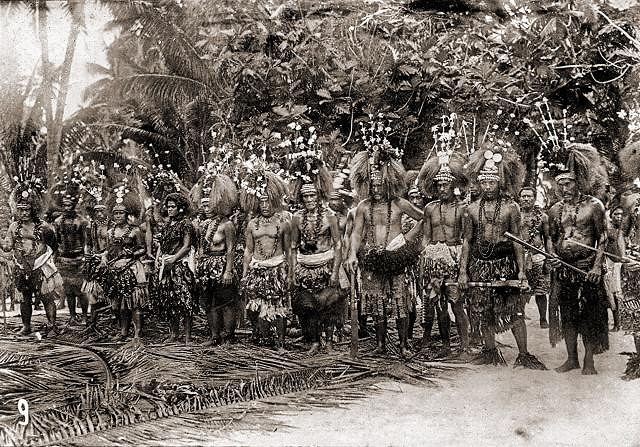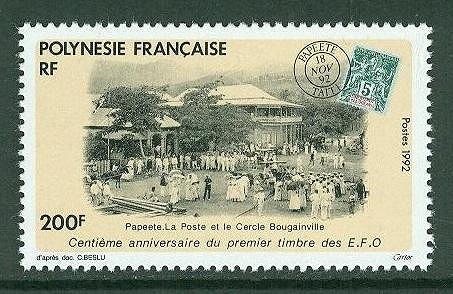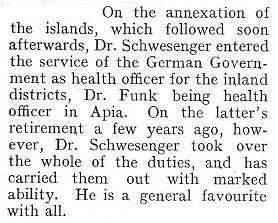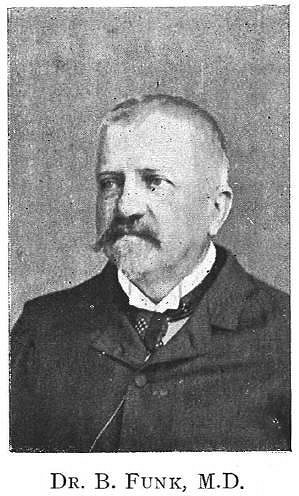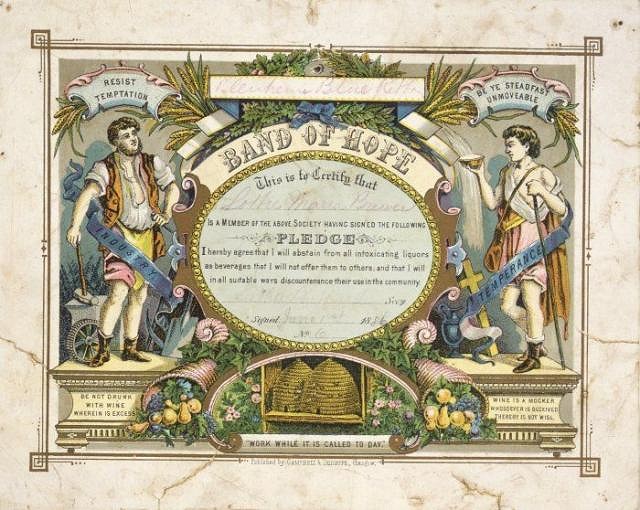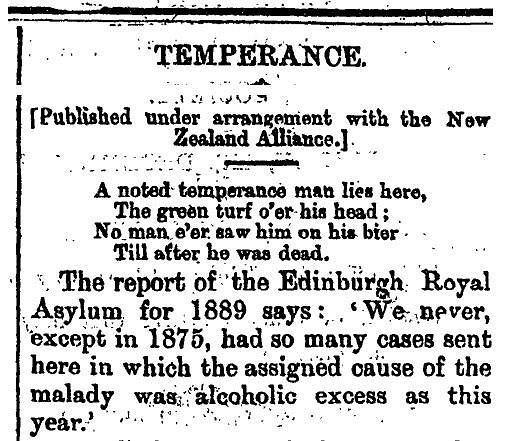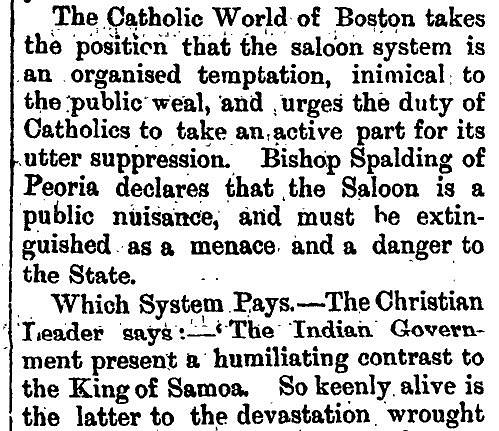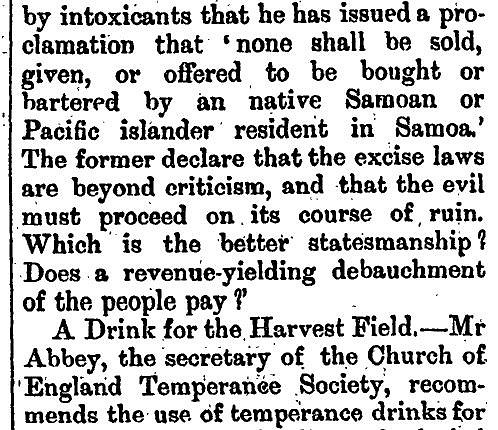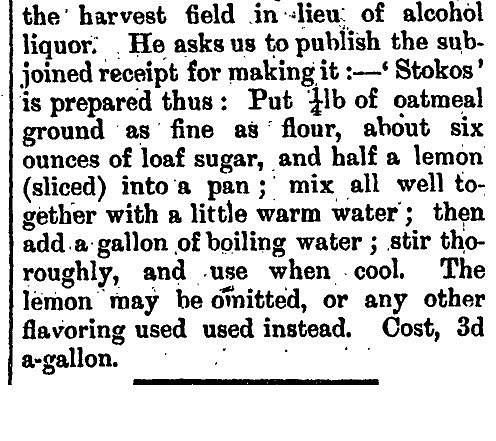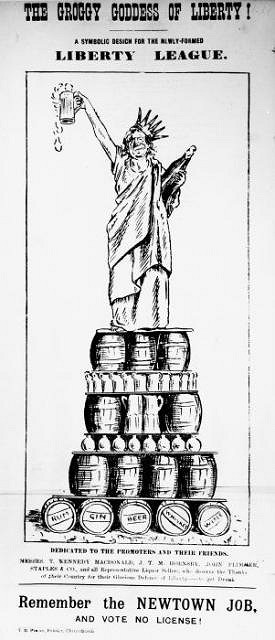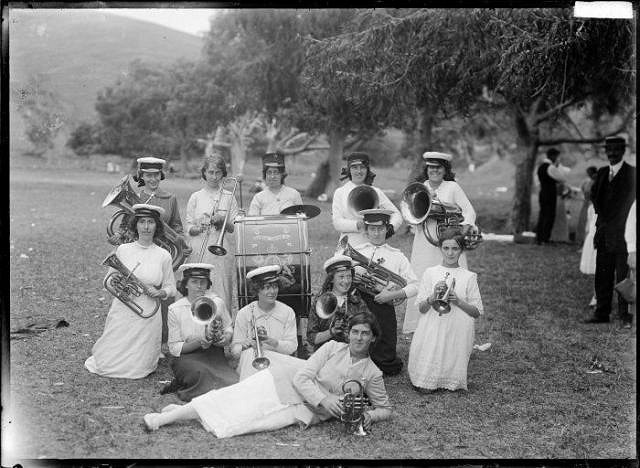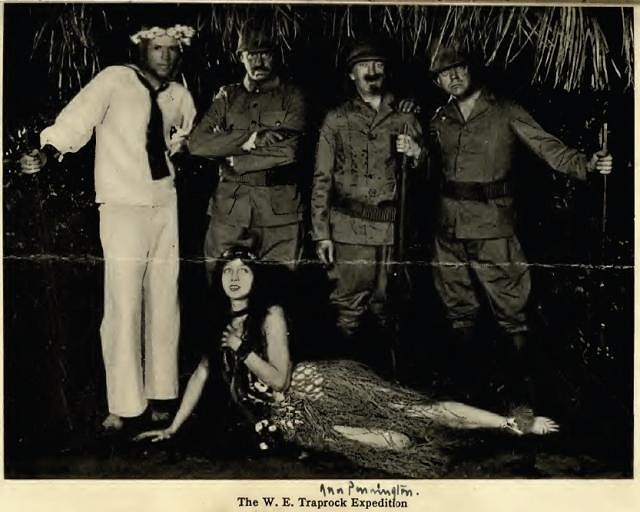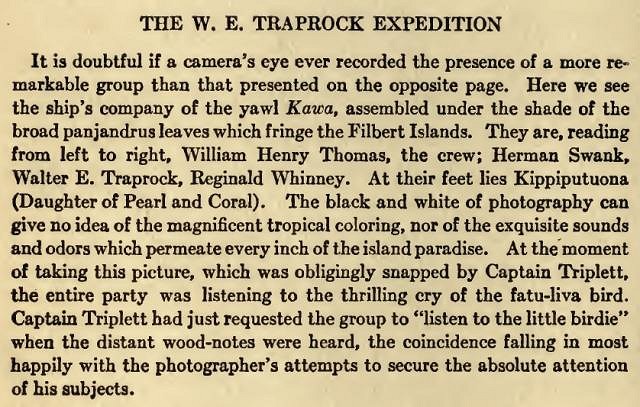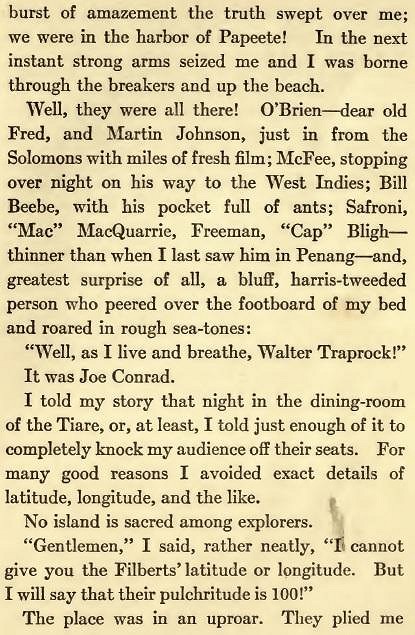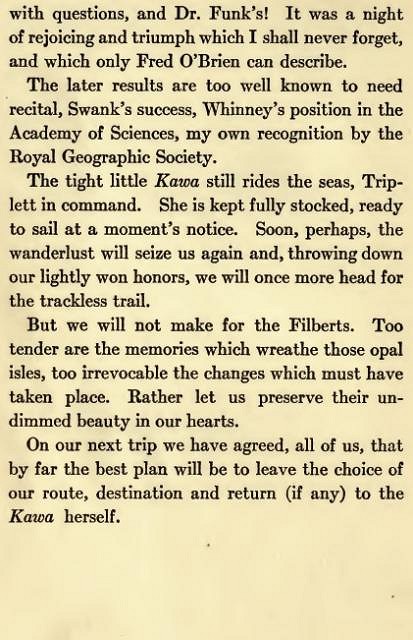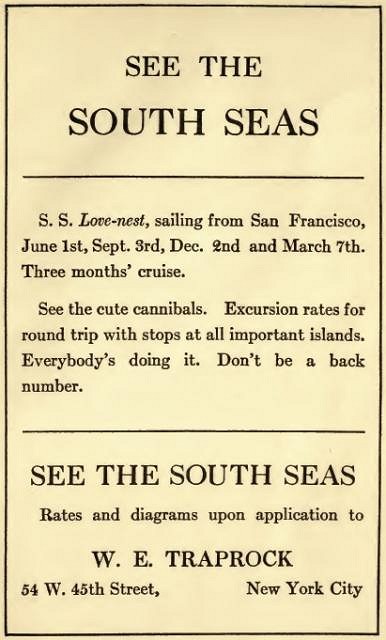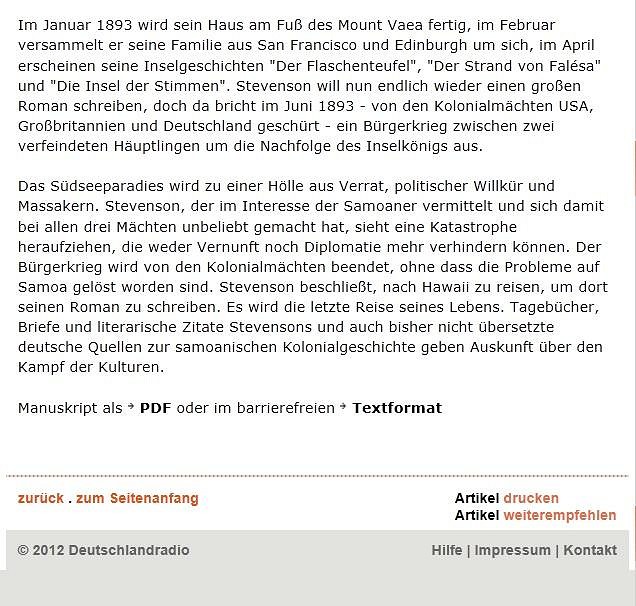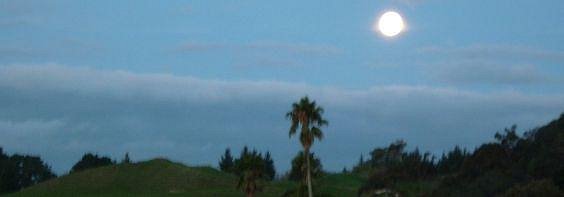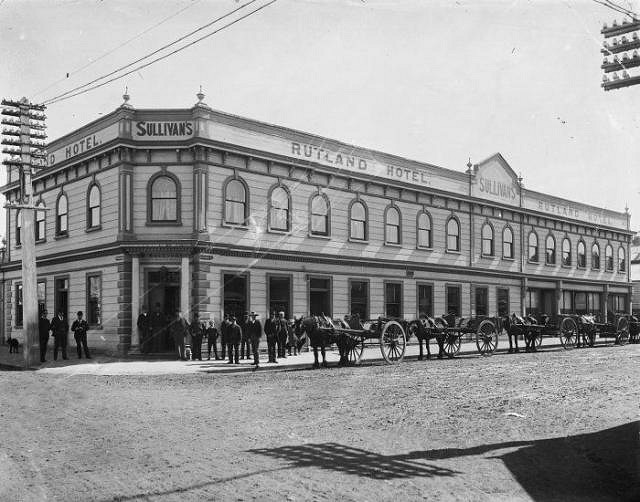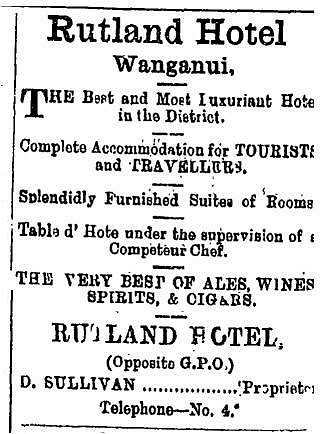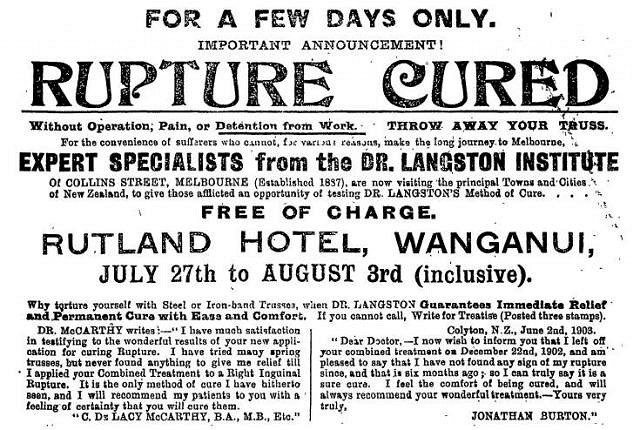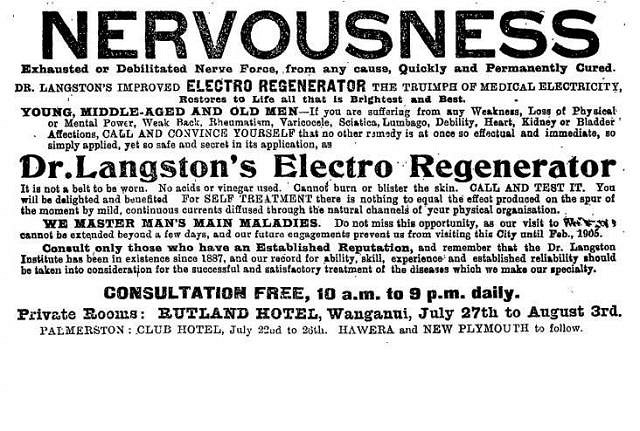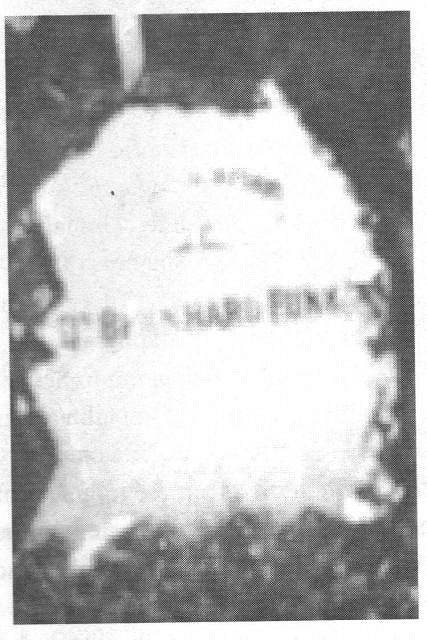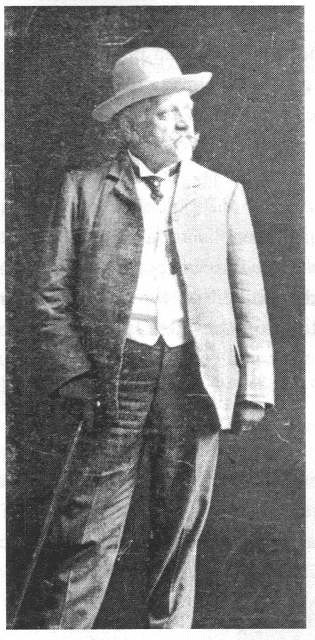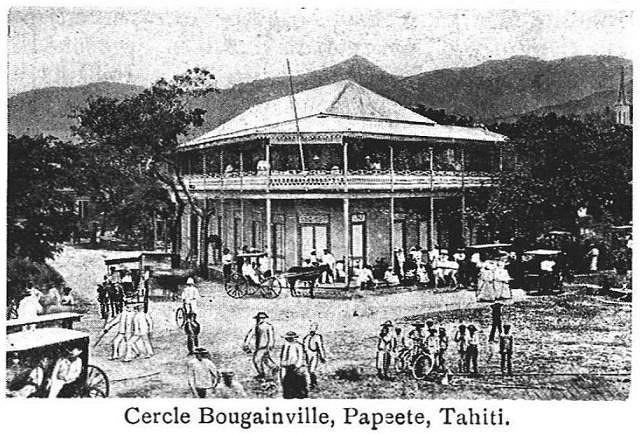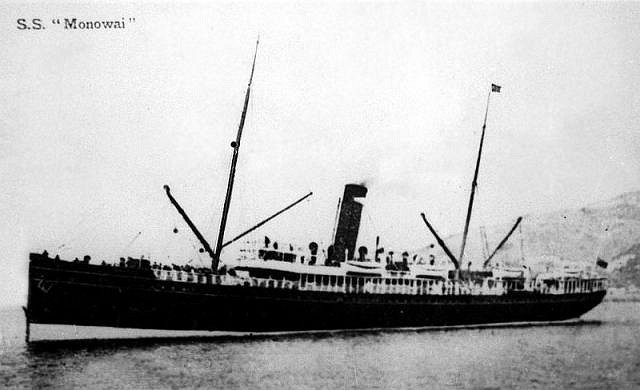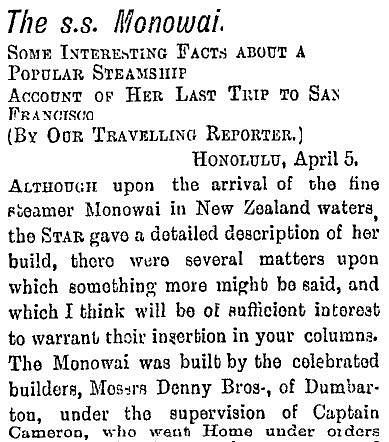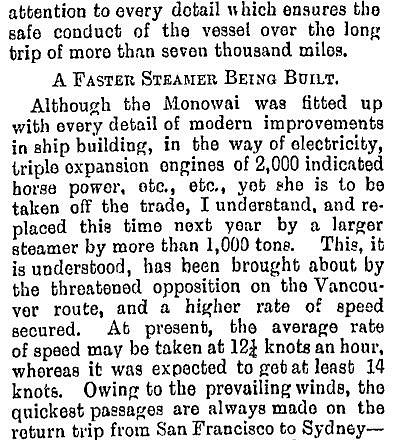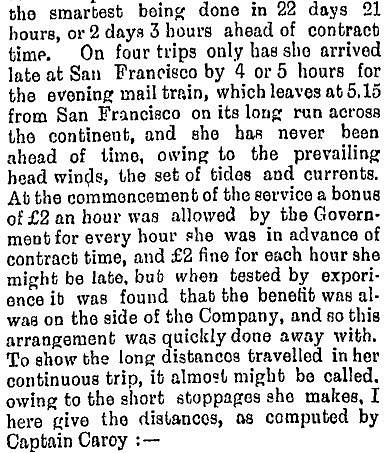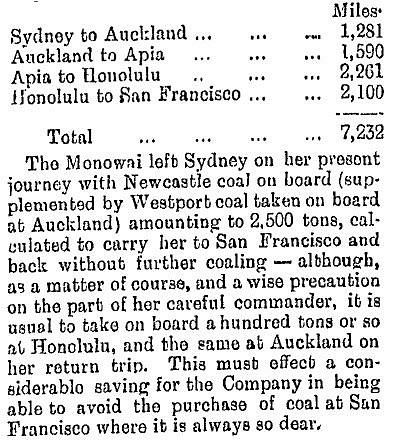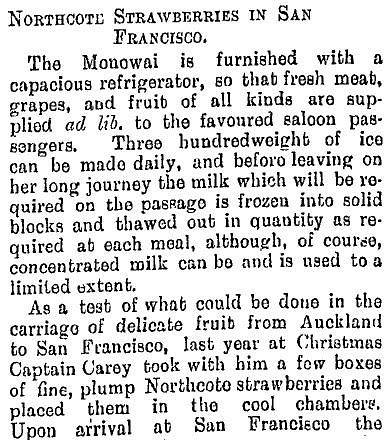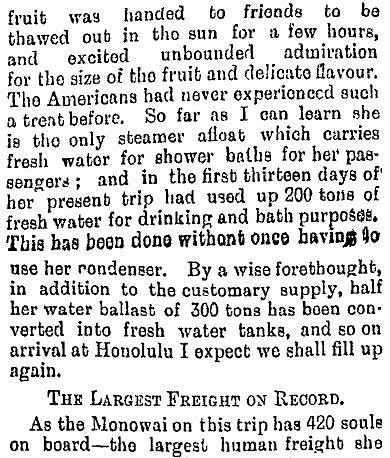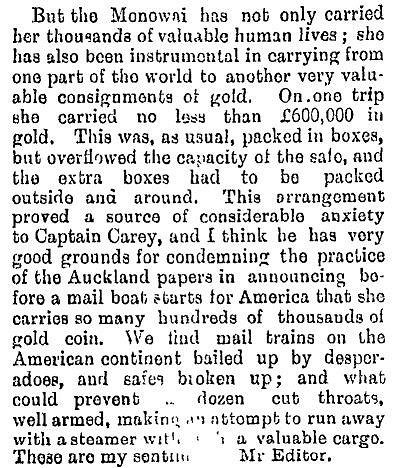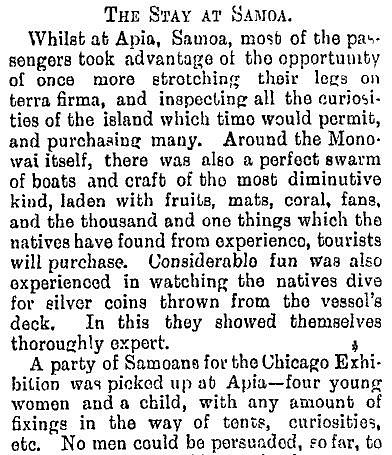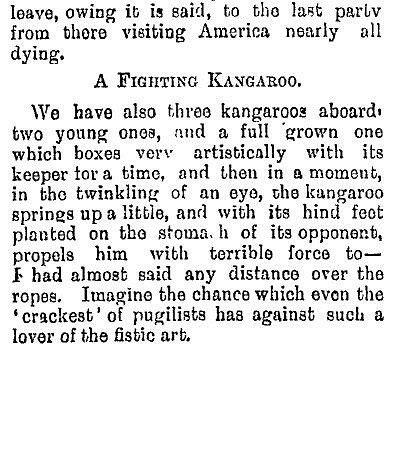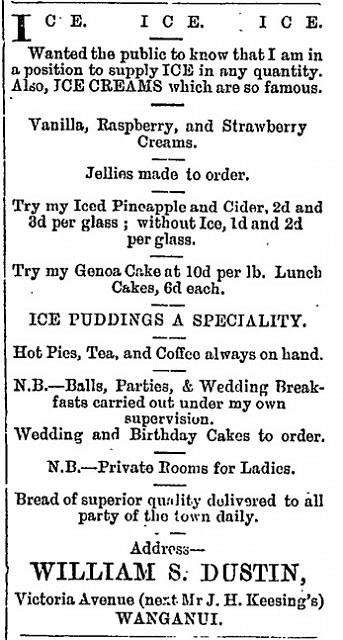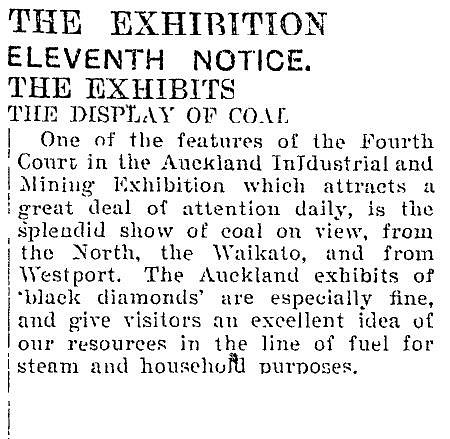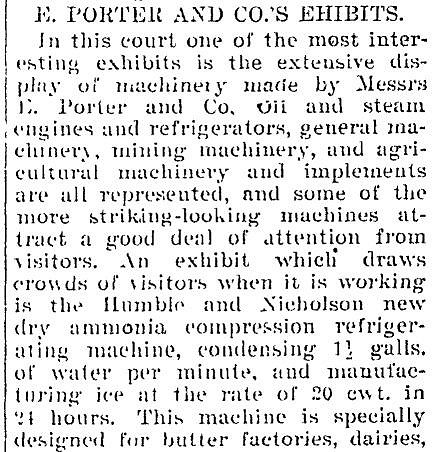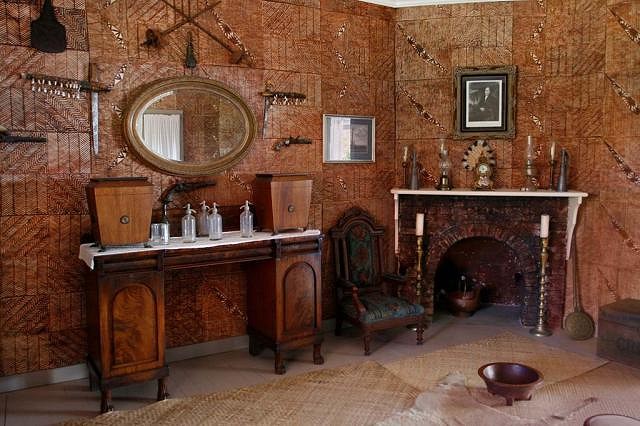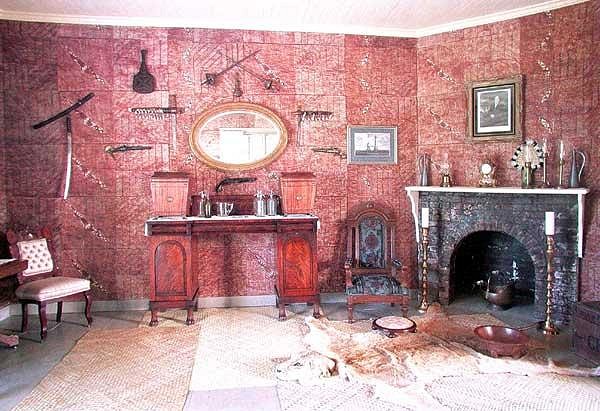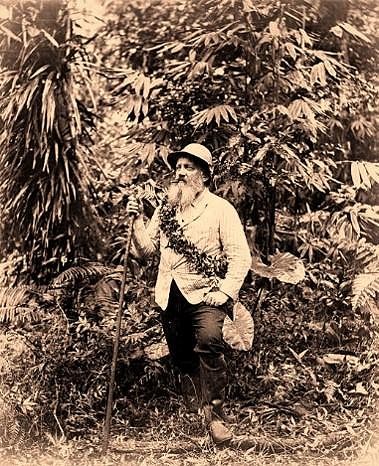Tiki Central / Tiki Drinks and Food
The real Dr. Funk
|
T

TikiTomD
Posted
posted
on
Fri, Mar 30, 2012 6:10 PM
Awesome, Sven... case of the mystery drink list conclusively and satisfyingly closed! Never knew Trader Vic had a 1940 footprint in Hawaii. I really like that cocktail menu cover design. My suspicions were that Trader Vic was involved when I read "...dirty stinker," practically a trademark phrase for Vic, one that is a common refrain in his bartending guide. -Tom |
|
T

TikiTomD
Posted
posted
on
Sat, Mar 31, 2012 9:46 AM
While we’re on an intermission in the RLS story in the “Tale of the Funk,” I thought I’d share another interest of our quirky medico, botany. Dr. Augustin Krämer extensively cited Dr. Funk over a whole range of subjects in his volume, The Samoa Islands: Material Culture, but especially on the subjects of native medicinal plants and meteorology. Krämer’s book was translated by Theodore Verhaaren and published by the University of Hawai`i Press in 1995. Here are but a couple of many citations...
Okay, that Krämer photo above has nothing to do with Dr. Funk and our topic of botany. It was included for purely ethnographic interest. The "Reinecke" cited by Krämer was Franz Reinecke, a German botanist who conducted field research in the Samoan archipelago from 1893 to 1895. For his botanical contributions, Reinecke named a rare flowering Samoan plant after Dr. Funk, Cyrtandra funkii. In his most recent compilation of rare Samoan plants for Conservation International, Art Whistler includes Dr. Funk’s namesake plant in a list of rare, endangered species that he recommends for the IUCN “Red List.” The IUCN (International Union for Conservation of Nature) is the main international agency concerned with endangered and rare botanicals and is headquartered in Switzerland. Cyrtandra funkii is on the bottom row of the lists shown in part below... The Rare Plants of Samoa January 2011
Should anyone come across Cyrtandra funkii in the wild, please take a photo, notify IUCN (phone: +41 (22) 999-0000) and leave it unharmed. -Tom |
|
T

TikiTomD
Posted
posted
on
Sun, Apr 1, 2012 6:59 AM
Continuing with the tale of Dr. Funk and his friend, Robert Louis Stevenson (RLS, or Louis to friends and family), here are some great photos from the National Library of New Zealand... **Robert Louis Stevenson, his family and Samoans, and the band of HMS Tauranga at Vailima, ca 1890 **Robert Louis Stevenson with Tuimalealufano at Vailima, Samoa, between 1889 and 1894 **Robert Louis Stevenson, shortly before his death, ca 1894 On December 3, 1894, Louis was at the dinner table making a salad dressing when he fell unconscious from an apparent cerebral hemorrhage (stroke). Lloyd Osbourne, his step-son, immediately went for his friend, Dr. Funk, but initially encountered Dr. Anderson, the naval surgeon of HMS Wallaroo, who arrived first at the scene. Dr. Funk, with a lame foot, arrived next, all within an hour. But nothing could be done. Robert Louis Stevenson breathed his last at ten minutes past eight, dying at 44 years of age. Belle (Isobel Strong), Louis’ step-daughter, wrote this in her journal on December 4 or 5, 1894, published in The Letters of Robert Louis Stevenson – Volume 8...
To be continued... -Tom |
|
T

TikiTomD
Posted
posted
on
Sun, Apr 1, 2012 10:25 AM
RLS lying in state at Vailima...
Robert Louis Stevenson’s burial took place at the top of Vaea Mountain, in accordance with his wishes, on December 4, 1894, the day following his death. In tropical climates, these things cannot be delayed. The native Samoans literally hacked a pathway up the steep mountainside from Vailima, and even so, it was a difficult climb, as explained in a December 9, 1894 letter from Maggie Stevenson, Louis’ mother, to Jane Balfour, recorded in Our Samoan Adventure...
As Maggie noted, only a few near and good friends were invited to attend. I’d have thought that Dr. Funk would be among those on that basis, except that with his lame foot and the extreme difficulty of the climb, I figured the 50-year old portly medico wouldn’t have been able to make it. Even Fanny, Louis’ wife, and Maggie, his mother, didn’t attend because of this. But I figured wrong, for the lengthy newspaper article below lists every attendee, and among them was our good Dr. Funk, who probably felt as if he’d lost a brother. The native Samoans must have literally carried him up... Boston Evening Transcript December 28, 1894 (page 28) RLS grave, after the burial...
A concrete memorial was later constructed over Louis’ grave...
1935 postage stamps honoring RLS...
Collection of vintage "Tusitala" editions of RLS works; recall that Tusitala was the Samoan name given to Louis, meaning "writer of tales" or "teller of tales"...
-Tom |
|
T

TikiTomD
Posted
posted
on
Sun, Apr 1, 2012 6:52 PM
So, what became of Fanny Stevenson after Louis’s death? This New York Times article published right after her death in Santa Barbara, California on February 18, 1914 recounts her life before and after Samoa. The irony is that she died of the same thing that killed Louis, a cerebral hemorrhage... New York Times February 20, 1914
Belle (Isobel Strong), Fanny’s daughter, made plans to return to Samoa with her brother, Lloyd Osbourne, in order to inter Fanny’s ashes at the top of Vaea Mountain alongside her husband... The Oxnard Daily Courier June 10, 1914 (page 2) After Fanny’s death, Belle married Ned Field, Fanny’s personal secretary and companion, becoming Mrs. Isobel Field. She and her new husband carried out her promise to Fanny. On June 22, 1915, Fanny Stevenson joined her late husband, Robert Louis Stevenson, at the top of Vaea Mountain... Poverty Bay Herald July 22, 1915
Aolele is Fanny’s Samoan name, meaning “flying cloud.” -Tom |
|
T

TikiTomD
Posted
posted
on
Mon, Apr 2, 2012 8:52 AM
You might be quite surprised, as I was, to learn that Dr. Funk is a major character in a work of contemporary fiction. It seems a Yorkshire physician, Dr. Richard Woodhead, had doubts about the prevailing assumption that the frail health of Robert Louis Stevenson was due to pulmonary tuberculosis (consumption). When he retired from his hospital post in 1997, Dr. Woodhead pursued all the available medical evidence and concluded that he couldn’t prove the issue one way or the other. So he decided to write a book that explored it through the first-person fictional narratives of the principal five doctors who treated Robert Louis Stevenson in real life. Dr. Woodhead explains his interesting approach on this web page, excerpted in part here...
The resulting book was The Strange Case of R.L. Stevenson, published by Luath Press Limited in 2001...
I purchased a copy and found it an interesting read. The book is in five sections, each section containing in multiple chapters the first person account of one of RLS’s physicians. Dr. Funk’s section is last as is chronologically appropriate. From all that I have learned about Dr. Funk and his relationship with RLS, Dr. Funk’s narrative is quite believable. For a sense of the book, here is Dr. Funk at home one evening, making a cocktail...
Even the Bum should be impressed by Dr. Funk painstakingly measuring each of his cocktail ingredients... The book is available new or used at Amazon.com, used from Barnes & Noble, and new directly from the publisher at Luath Press Limited. -Tom |
|
T

TikiTomD
Posted
posted
on
Tue, Apr 3, 2012 3:17 PM
I was fortunate to locate a copy of Some Recollections of Early Samoa by H. J. Moors at the World of Rare Books in Goring by Sea, West Sussex, United Kingdom. This book is a compilation of weekly articles originally written by Moors for the Samoa Times from 1924 to 1926. It was published by the Western Samoa Historical and Cultural Trust in 1986. Recall that Moors, an old time resident of Apia, Samoa, was the American merchant who had befriended Robert Louis Stevenson. It was Moors who purchased land on behalf of Louis and then built his Samoan home, Vailima. Here are photos of the man in his youth and from later in life, both from this book...
Moors passed away in 1926... The Sydney Morning Herald March 16, 1926 In an October 17, 1924 Samoa Times article, Moors listed from memory the early colonial settlers of Samoa...
Dr. Funk was included on the list, as seen from this excerpt...
Moors went on to say, in part...
-Tom |
|
T

TikiTomD
Posted
posted
on
Tue, Apr 3, 2012 3:43 PM
The following is an excerpt of an article from the September 12, 1924 edition of the Samoa Times by H. J. Moors, republished in Some Recollections of Early Samoa. The last line appears to be stating that Dr. Funk, as Apia Municipal Council medical officer, was charged with performing health inspections of the Samoan madams who provided evening entertainment to visiting sailors and traders...
Here are views of the Apia waterfront from Some Recollections of Early Samoa...
And a view of Mainstreet Apia, also from Some Recollections of Early Samoa...
Here are a few Apia street scenes from the National Library of New Zealand... **Samoa. Street scene, Apia, ca 1900 **Samoa. The Casino Hotel, Apia, ca 1900 -Tom |
|
T

TikiTomD
Posted
posted
on
Thu, Apr 5, 2012 11:49 AM
A Samoan mystery: How did the goldfish get into Lake Lanoto`o, also known as Goldfish Lake?
Lake Lanoto
Lonely Planet describes the lake thusly...
Samoan tradition is that the lake has no bottom (apparently the source for the Lonely Planet observation), but an American geologist, James Dana, from the United States Exploring Expedition of 1838 to 1842 determined the deepest point of the lake to be about 60 feet...
The trail to the lake is obscure (local guide recommended) and the climb is steep and strenuous...
On the trail, if fortunate, one might encounter the Tooth Billed Pigeon (Manumea), Crimson Crowned Fruit Dove (Manutagi) or Red Headed Parrot Finch (Manu Ai Pa Leilani Burgoyne’s paper, “Going ‘Troppo’ in the South Pacific: Dr. Bernhard Funk of Samoa 1844–1911,” identifies Dr. Funk as the one who released goldfish into Lake Lanoto`o. This was in direct violation of laws forbidding the introduction of alien species into Samoa and came after repeated warnings from Dr. Wilhelm Solf, the Imperial German Governor of Western Samoa, for whom Dr. Funk worked in his post as Harbor Doctor. Leilani cites George Westbrook as stating that Dr. Funk was the first person to open up Lake Lanoto`o as a health resort and place of recreation. In her letter to the editor of the Samoa Observer, Dr. Heidrun Schmidt, Dr. Funk’s great-grandniece, also noted that at ”Lake Lanutoo he [Dr. Funk] initiated the laying out of a wonderful recreation centre with huts on the top and a wharf ashore and he also put goldfish in the lake, which are still present.” Those huts were presumably in the form of Samoan fale. Leilani goes on to note in her paper that Dr. Funk was so preoccupied with the construction and operation of his health resort, it likely impeded his ability to effectively perform official duties as a government medical officer. In particular, she cites an early 1903 letter from Erich Schultz on behalf of Governor Solf requesting his immediate return from the lake, having failed to show up for work after six weeks of authorized leave. Dr. Funk evidently missed no opportunity to antagonize Solf, as we shall see in a later post. Picture this: Dr. Funk’s Crater Lake Sanitarium where one approaches the bar beneath a palm-thatched fale and orders “zwei Arzt Funks“ while native Samoans entertain with traditional songs and dances, and the eyes wander along the verdant misty shoreline of Lake Lanoto`o where lovely maidens frolic among the goldfish...
So, the Samoan mystery is solved: Dr. Funk did it. -Tom |
|
T

TikiTomD
Posted
posted
on
Fri, Apr 6, 2012 6:03 AM
Some additional items to share regarding Lake Lanoto`o... I ran across this July 26, 2010 blog post that seems to be related to the quest of Dr. Heidrun Schmidt, Dr. Funk’s great-grandniece, relative to the old Lake Lanoto`o health resort...
Of course, Dr. Funk had passed before even WWI, and New Zealand, at the request of the British, took Western Samoa from the Germans without bloodshed in 1914, so that last part is myth. No doubt there is a collective Samoan memory of Dr. Funk that has grown a bit in the retelling, as historic events experienced by succeeding generations infiltrated that memory. But what a movie scene that would be, with the 100-year old, cigar-chewing German medico spilling his drink and dodging as Brewster Buffalo fighters (“flying coffins”) of the Royal New Zealand Air Force strafed the Pandanus-lined shores of Lake Lanoto`o! As the fighters rumble away having failed again, said medico gives them the appropriate finger salute. I’m thinking that Burl Ives would have been about perfect for the role of Dr. Funk... Here’s a description of Lake Lanoto`o from the 1909 book by Oscar Vojnich, a Hungarian Baron who journeyed throughout Oceania starting in 1906 and recorded his observations in The Island-World of the Pacific – Journey Notes...
Too bad about that photo deterioration! I also came across this 2009 technical paper that asserted no one had previously even ascertained the depth of Lake Lanoto`o before the authors’ investigation. As almost 170 years had elapsed from the time that the U.S. Exploration Expedition had sounded the lake (see prior post), they can probably be forgiven the oversight...
The lake depth determined by these investigators, 52.5 feet (16 meters) was remarkably close to that determined by the U.S. Exploration Expedition, 57 feet (9.5 fathoms). The difference could reasonably be attributed to accumulation of sediment and detritus over the centuries. Recall the sounding technique used on the U.S. Ex. Ex...
-Tom |
|
T

TikiTomD
Posted
posted
on
Sat, Apr 7, 2012 5:08 PM
In February of 1900, the three colonial powers with interests in Samoa formally ratified agreements proposed in the Tripartite Convention of 1899. In accordance with these agreements, Western Samoa (Upolu, Savai`i, Apolima and Manono) became a protectorate of Germany. Eastern Samoa (principally Tutuila with its harbor, Pago Pago) was ceded to the United States. The United Kingdom was compensated by the handover of former German interests in Tonga, the Solomon Islands, West Africa (division of the neutral zone) and Zanzibar. Dr. Wilhelm Solf, one of Germany’s finest civilian diplomats, was appointed as the Imperial German Governor of German (Western) Samoa. He was 38 years old at the time...
Just the year before, in 1899, Dr. Solf had been appointed as President of the Apia Municipal Council, a multi-national provisional government. This newspaper article about that appointment has some good biographic data on Dr. Solf… Boston Evening Transcript March 31, 1899 (page 1) Bigbrotiki, note the reference to student dueling scars... Solf had a prominent “schmiss” on his chin. The American explorer and journalist, Lewis R. Freeman, wrote about Solf in his travelogue, In the Tracks of the Trades, published in 1921...
On Dr. Solf’s effectiveness as German Governor of Western Samoa, Freeman went on to say...
Dr. Solf was noted to be both humane and tolerant, but decisively acted whenever and wherever his imperial authority was questioned. There were some other dimensions to Wilhelm Solf that have bearing on his relationship with Dr. Funk. Solf strongly believed that people should stay in their own racial lanes, so to speak. He found intermarriage with the Samoan natives to be abhorrent, as observed by Peter Hempenstall and Paula Mochida in their 2005 book, The Lost Man – Wilhelm Solf in German History...
Dr. Funk, like many of the old time settlers and small plantation owners, had married native Samoan women. That made them all moral degenerates in the view of Solf, who likewise discounted their claims and ties to Samoa as a new home. In part, Solf felt a fatherly obligation to protect the native Samoan people from corruption by these settlers. On the debilitating effects of climate, Leilani Burgoyne in “Going ‘Troppo’ in the South Pacific: Dr. Bernhard Funk of Samoa 1844–1911” noted that Solf believed in a condition referred to as Troppenkoller, a form of tropical madness affecting settlers from northern climates brought on by the sustained exposure to high heat and humidity in Samoa and other South Seas islands. This condition caused those affected to lose their sense of perspective and react psychologically in incomprehensible ways. In his view, twenty five years was the maximum limit of exposure before even the hardiest of Europeans succumbed either to the effects of the climate or the seductive wiles of native women. On the latter point, I’d say that Solf was being way too generous. Based purely on elapsed time of exposure, Dr. Funk was on the verge of going “Troppo.” Hempenstall and Mochida in The Lost Man – Wilhelm Solf in German History go on to explain the underpinnings of Solf’s native policy...
Dr. Solf seriously underestimated the native Samoans, especially the wily intelligence of one of their great orator chiefs, Lauaki Namulau`ulu Mamoe. The orator chiefs (tulafale) were the kingmakers among Samoan royalty, and Solf’s policies disenfranchised their position. Solf would later bitterly regret that miscalculation, as subsequent insurrection forced him to ship the great chief, supporting chiefs and families (nearly seventy people in all) into exile on the German Mariana Islands in the far North Pacific… **Lauaki Namulau'ulu Mamoe and other chiefs, aboard a German warship, 1909 After taking office as Imperial Governor of Western Samoa in March of 1900, Dr. Solf established a permanent post for a government medical officer. Solf had serious reservations about the obvious candidate, Dr. Bernhard Funk, due to the issues cited above and Funk’s stubbornly independent, even “cheeky” nature, according to the evidence uncovered by Leilani Burgoyne. In the end, Dr. Funk’s popularity across all elements of the community and his solid medical reputation caused the administration to award him the post of Harbor Doctor. At the time, Dr. Funk was 55 years old. Interestingly, Leilani found that Dr. Funk was unable to produce his medical papers, so he was forced to share his official responsibility with another German physician. None of this bode well for a happy working relationship between the Imperial Governor and his new employee. Dr. Solf and his new medical officer, Dr. Funk, went on a diplomatic and trade tour of New Zealand and Australia in 1901, according to these newspaper articles of the time... The Wanganui Herald March 18, 1901 The Evening Post March 23, 1901 **Dr and Mrs Solf at Vailima, 1900s Once Dr. Funk accepted his government post, the Imperial Governor and his administration determined who Dr. Funk’s patients were, and these were typically Samoans of significant political influence. As he feared, Solf repeatedly found his doctor unresponsive to his requests. Leilani cites a 1903 letter from Solf to Funk demanding an explanation as to why he, Funk, had not attended to the *Ali In 1904, Dr. Funk was accused by the Imperial Governor of doing the unforgiveable, consorting with his arch political foe, Dr. Richard Deeken, a reserve army officer and head of the small planters’ association known as the Planters’ Society (Pflanzerverein). Malama Meleisea and Penelope Schoeffel Meleisea summarized Solf’s situation with Deeken in their 1987 book, Lagaga: A Short History of Western Samoa...
**Dr Richard Deeken**, his wife Elisabeth and their first child "Else Josepha Moana,” 10 month old godchild of the last king of Samoa, Josefa Mata'afa (1903) According to Leilani, the records reveal that Solf accused Dr. Funk of “showing off with Deeken in the street” after having him over for dinner. Dr. Funk proclaimed his innocence, saying that he knew Deeken in his capacity as physician only and that he was willing to swear an oath that he had no part in slandering the German administration. Solf evidently decided he’d had enough. He declared Dr. Funk had gone “Troppo” and abolished his post as Harbor Doctor on July 1, 1904. Dr. Funk was almost 60 years old at the time and had been in Samoa more than twenty four years. Solf did allow Dr. Funk to continue in an official capacity collecting meteorological data for the Seewarte in Hamburg, as well as for the German Firm (D.H.P.G.). He also allowed Dr. Funk to intermittently serve the administration when other doctors weren’t available to attend patients. Here’s how Hempenstall and Mochida described the action in The Lost Man – Wilhelm Solf in German History...
Dr. Wilhelm Solf left Samoa in 1910 to be appointed Colonial Secretary at Berlin. Dr. Erich Schultz, his deputy and the former chief justice in the protectorate, succeeded him. Dr. Solf died in 1936... Rochester Journal February 6, 1936 (page 63) **Samoan address to outgoing German Governor, Dr Wilhelm Solf, 1910 For the rest of the story on Dr. Solf, see this Samoa Observer online article. Dr. Solf was a political moderate and opposed the rising National Socialist (Nazi) party in Germany. His wife, Johanna Solf, and their Samoan-born daughter, Lagi (So German Postcard of Samoa (1907) -Tom |
|
T

TikiTomD
Posted
posted
on
Mon, Apr 9, 2012 4:12 PM
Before Dr. Wilhelm Solf (Dr. Funk’s old boss) left his post as Imperial Governor of German (Western) Samoa in late 1910, Christian Wilhelm Allers, a well-known German artist, made a portrait of him while in Apia, dated April 22, 1910, that clearly shows his dueling scars (“schmiss”)...
Thirteen years later found Dr. Solf in Tokyo as German Ambassador to Japan at the moment when the devastating 1923 Yokohama earthquake hit in the midst of a typhoon... Southeast Missourian September 6, 1923 (page 1) Back in Samoa at the time, the native Samoans were extremely unhappy with the way New Zealand was administering the protectorate and longed for the old days when Germany ruled the colony under Dr. Solf. Having learned that Dr. Solf survived the earthquake in Japan, a group of Samoan chiefs sent him telegrams begging for his return as their Governor, according to Hempenstall and Mochida in The Lost Man – Wilhelm Solf in German History, as well as Hermann Hiery in his 1995 book The Neglected War: The German South Pacific and the Influence of World War I, excerpted below...
The Samoan warriors in the photo below appear to be in an ugly mood. They’ve likely had their fill of the crazy papalagi (foreigners) and their rules, so heads are about to be taken. Photo, dated ca 1900, is a post by ookami_dou (Wolfgang Wiggers) on Flickr...
-Tom |
|
T
TropicDrinkBoy
Posted
posted
on
Mon, Apr 9, 2012 6:03 PM
This is all well and good, and I mean no disrespect, but inquiring minds want to know what is the definitive historically accurate Dr. Funk cocktail? I like Trader Vic's Dr. Funk of Tahiti but what was the good doctor actually drinking? |
|
T

TikiTomD
Posted
posted
on
Tue, Apr 10, 2012 4:13 PM
TropicDrinkBoy, quite a reasonable request, considering the title of this forum. I’ve been winding my way through Dr. Funk’s life story and the side trails connected to it, but I’ll put the final few posts about that on hold to cut to the chase on your question... The earliest known Dr. Funk cocktail recipe is that which has already been posted by Mr. Bali Hai from Frederick O’Brien’s 1921 book, Mystic Isles of the South Seas. Leilani Burgoyne’s paper from the University of Auckland is the most meticulously researched work on all things about Dr. Bernhard Funk, yet she could find nothing earlier among unpublished and published papers. I’ve made an extensive search myself, combing through both online and physical books, even the 1907 Cyclopedia of Samoa, with no better result. So, I circle back to that recipe given by Dr. Funk to Joseph, the steward at the Cercle Bougainville in Papeete, Tahiti about a century ago and recorded in Mystic Isles of the South Seas...
Note that this recipe contained no rum at all. Here’s where O’Brien made it clear that it was to Joseph that Dr. Funk directly confided the recipe...
The cocktail’s popularity was enhanced by the fact that a real physician had concocted it (from online copy of Mystic Isles of the South Seas)...
Here are various other snippets about the cocktail in Mystic Isles of the South Seas...
Among factors supporting the recipe as authentic are that it is contemporary to Dr. Funk’s lifetime and all the recorded details about the doctor himself are accurate. It’s almost 20 years after Mystic Isles of the South Seas was published that Dr. Funk appears next, in altered form... Beachbum Berry’s Intoxica! (page 32) has a Doctor Funk recipe cited as originating from Don the Beachcomber circa 1937. It adds dark rum to the mix and alters proportions. Absinthe (no longer legal) has been replaced by Pernod. Earlier in this thread, we saw where Trader Vic already had a dark rum and absinthe Dr. Funk cocktail on the menu of his Honolulu Trader Vic’s, circa 1940. -Tom [ Edited by: tikitomd 2012-04-10 16:40 ] |
|
T
TropicDrinkBoy
Posted
posted
on
Wed, Apr 11, 2012 1:13 AM
Thanks very much Tom for the recipe and all the background info. I love a drink with a story and this one is a doozy! I'll make an original Dr. Funk in the next day or so. The first Dr. Funk of Tahiti I had at Trader Vic's was perfect with the float of Pernod in balance. That's hard to get right. |
|
T
TropicDrinkBoy
Posted
posted
on
Wed, Apr 11, 2012 1:14 AM
Thanks very much Tom for the recipe and all the background info. I love a drink with a story and this one is a doozy! I'll make an original Dr. Funk in the next day or so. The first Dr. Funk of Tahiti I had at Trader Vic's was perfect with the float of Pernod in balance. That's hard to get right. |
|
CN
Club Nouméa
Posted
posted
on
Thu, Apr 12, 2012 1:46 AM
Wonderful thread with lots of amazing research. This section raised a smile:
Several years ago I nearly bought a house off a Samoan family in Porirua, and they had built one of these evening drinking & entertaining fales out in the back yard!!! Unfortunately they hadn't got a building permit from the City Council, and also the house had dry rot, so I had to walk away :( |
|
T

TikiTomD
Posted
posted
on
Fri, Apr 13, 2012 12:35 PM
TropicDrinkBoy, please be sure to share the results of your experiment with the original Doctor Funk recipe, including ingredient proportions, as there is quite a bit of ambiguity in “a portion of absinthe.” Club Nouméa, the fale seems the perfect pre-Tiki architecture for entertaining in tropic climes. Interesting that you would find one in a New Zealand back yard. Picking back up with the tale of Dr. Funk, the person... Recall that the Imperial Governor of German Samoa, Dr. Wilhelm Solf, had found the fiercely independent Dr. Funk to be every bit as difficult to control as he had initially feared. However, compared with the major league troubles he faced in balancing the interests of the German Empire and those of the native Samoans, Dr. Solf likely found Funk to be a relatively minor and sporadic irritation... that is, until Funk socialized with Richard Deeken, head of the small planters’ association and arch political foe of the Governor. With that transgression, Solf was highly offended and hurt; it was beyond belief that anyone in his own administration would be associated in any capacity with Deeken. So, in July of 1904, the Governor dismissed Dr. Funk. The newly unemployed Funk was nearly 60 years old. The Deeken affair convinced the Governor beyond a doubt that Dr. Funk had gone “Troppo” and was no longer up to handling the rigors of the job. Wilhelm Solf must have retained a soft spot for his old medico and a degree of professional respect, for he continued to employ Dr. Funk as a physician on a casual basis. He also allowed him to continue making meteorological observations for the government. In a much earlier post, we saw that in 1910 the German administration officially acknowledged Dr. Funk’s lifetime meteorological contributions by awarding him the Order of the Red Eagle (4th Class), a major civilian honor. This could only have happened with Solf’s endorsement and approval. In The Cyclopedia of Samoa of 1907, Dr. Funk was observed to have retired in 1904 (not been fired), another accession on the part of Solf, under whose authority this work was published...
I love the publisher’s note at the beginning of The Cyclopedia of Samoa, which reads in part...
Here’s an excerpt from the biographic sketch of Dr. Schwesenger, who replaced Dr. Funk as Apia health officer...
From the biographic sketch of Dr. Funk, we get a snapshot of our irrepressible medico in his early 60s, as well as a sense of how attached he was to Samoa and Samoa to him...
On his assessment, in part, of the health threats to the native Samoans...
Curiously, there is no mention of Doctor Funk, the cocktail, not even in the accompanying The Cyclopedia of Tahiti... -Tom |
|
B
bigbrotiki
Posted
posted
on
Fri, Apr 13, 2012 2:04 PM
One can maybe assume that, from a German and European standpoint, compared to all the scholarly research into culture and other scientific aspects of the locale worthy of being published, the mention of a recreational alcoholic beverage was viewed as too trivial, or maybe even reprehensible. It fell to other places and peoples to raise it to a level of legendary stature. So Tom, when is YOUR book coming out? :) |
|
T
thePorpoise
Posted
posted
on
Fri, Apr 13, 2012 2:07 PM
book? he's negotiating the screenplay and movie rights! |
|
T

TikiTomD
Posted
posted
on
Sat, Apr 14, 2012 6:37 AM
Sven, I’m thinking the “or maybe even reprehensible” predominantly applied. Missionaries were early or earliest on the scene throughout Oceania. Then, from the mid 19th century on into the 20th century, temperance movements were gathering strength all over the world, to include Oceania, especially New Zealand and Australia. It probably was not a good time to publically glorify your prize cocktail, lest you become a target... **Band of Hope Temperance Society. Blenheim Blue Ribbon Branch :This is to certify that [Lottie Maria Brewer] is a member of the above society having signed the following pledge. [Luther Shelford, June 1886. no 6]. Published by Campbell & Tudhope, Glasgow. The Clutha Leader December 5, 1890 Disclaimer: The following graphic containing “Groggy” is not intended as a reference to anyone living or dead (not you either, GROG). Artist unknown: The Groggy Goddess of Liberty; a symbolic design for the newly-formed Liberty League, dedicated to the promoters and their friends. ... Remember the Newtown job, and vote No License! [1890s?] **Temperance Ladies' Brass Band, possibly in Auckland, [ca 1910s]
As much fun as this is, that may have to wait awhile, as I have a demanding day job launching rockets. I’m quite happy to be a contributor.:)
Porpoise, you’re on to something there. Oceania in the 19th and early 20th centuries had all the elements to make a multitude of great movies: gorgeous scenery, conflict among indigenous peoples of many origins among themselves and with the colonials, intrigue among the traders and three major colonial powers, interesting historic characters (native and papalagi), and it had pirates! In Papeete, the Cercle Bougainville with it polyglot steward, Joseph, seems a South Seas incarnation of Rick’s Café in the movie Casablanca. -Tom |
|
T

TikiTomD
Posted
posted
on
Sat, Apr 14, 2012 11:56 AM
It was bound to happen. There were so many South Seas adventure stories and travelogues being published around the end of the 19th century and beginning of the 20th century that someone saw an opportunity to cash in on satire. That someone was George Shepard Chappell, a professional architect and friend of the publisher George Putnam (husband of Amelia Earhart). Using the pseudonym Dr. Walter E. Traprock, he published in 1921 The Cruise of the Kawa: Wanderings in the South Seas. This book poked fun in particular with Frederick O’Brien’s South Seas travelogues. Here’s the Amazon.com description of the book...
In the excerpt below, the crew of the Kawa has been lost for some indeterminate time, having intended to land in Tahiti. Giving up all hope, they abandoned the tiller and proceeded to consume the last of their food and drink in a final party, described as a wild orgy that lasted two days before they exhausted all supplies. During that time, the Kawa sailed free of crew intervention and, just as the supplies ran out, crashed onto the shore of their intended destination, Papeete. In the onshore celebration that follows, Doctor Funk’s are the alcoholic beverage of choice...
This web site has more information on George Chappell, including a comic strip based on Dr. Walter E. Traprock, world renowned explorer and adventurer.
-Tom |
|
T

TikiTomD
Posted
posted
on
Sun, Apr 15, 2012 10:55 AM
Dr. Funk apparently has a greater footprint in modern fiction than I previously thought. In an earlier post, you found that he told his story as one of five real-life physicians who treated Stevenson in The Strange Case of R.L. Stevenson by Richard Woodhead, published by Luath Press Limited in 2001. In 2011, Dr. Funk had a starring role in a radio play broadcast on Radio Germany, Die Teufel auf Samoa or, in English, The Devil in Samoa, by Holger Teschke...
The play is described as follows...
For those who can’t read German (like me), here’s a place where the online Google translator provides outstanding service. The Google toolbar will offer to translate the web page above or you can go directly to the text version of the radio play here, again asking Google to translate from German to English. A small excerpt...
There’s even an exchange between Dr. Funk and Robert Louis Stevenson about a Tongan Goddess Tiki! -Tom |
|
CN
Club Nouméa
Posted
posted
on
Sun, Apr 15, 2012 7:59 PM
And Dr Funk came to Wanganui in 1901! The Rutland Hotel (rebuilt in brick circa 1910) burned down in the 1990s, but the Rutland Arms stands on the same spot. What amazes me even more is that there was a German Consul in Aramoho in 1901. Whatever for? It looks very suspicious to me... (shades of John Buchan's The 39 Steps) For those not familiar with it, Aramoho is upriver from Wanganui. In those days it was a mere village and is now a somewhat down-at-heel suburb. There was an unsuccessful attempt at establishing a zoo there a hundred years ago, but they had to close it down because the neighbours complained about the roaring lions waking them up in the middle of the night. The temperance movement was very strong here, although prohibition was never introduced nationally, as the drinking culture is even stronger. A referendum on introducing prohibition was included in national election ballot papers here from 1911 up until 1987. My mother always used to vote for it, and then come home and tell me "that'll teach the so-and-sos for going out drinking and neglecting their wives!"
[ Edited by: Club Nouméa 2012-04-15 21:09 ] [ Edited by: Club Nouméa 2012-04-15 21:17 ] |
|
T

TikiTomD
Posted
posted
on
Mon, Apr 16, 2012 11:49 AM
Club Nouméa, do any of the Wanganui bars offer a Doctor Funk cocktail? I’m guessing that Tahiti, being a French colony, was the perfect place to introduce and create a legacy for an absinthe-containing drink, given the French national predilection for this spirit. Doctor Funk, the cocktail, may have been introduced to any of a number of other locales where it ultimately failed to catch on due to the absinthe content. It took the French expatriates in Papeete to elevate it to popular drink status and, of course, Frederick O’Brien to spread the word and record the particulars for all time in his book.
**Sullivan's Rutland Hotel, corner of Ridgway Street and Victoria Avenue, Wanganui, [ca 1910] The Wanganui Chronicle March 24, 1898 According to this article, a principal reason for Governor Solf’s visit to New Zealand in 1901 was health, maybe the reason Dr. Funk was his co-traveler of record... Morning Oregonian February 11, 1901 Could it be that the Governor was there to see visiting specialists from the Dr. Langston Institute? The Wanganui Herald July 15, 1904 -Tom |
|
CN
Club Nouméa
Posted
posted
on
Mon, Apr 16, 2012 7:15 PM
Well, mine does - I have made been making them up for visitors to try for a couple of years now (mainly because the drink was so famous in the French Pacific, and that's part of the theme of my bar). I will definitely have to get that photo of the good Doctor framed and hanging by the bar now. I am also going to start looking around antique stores for that Electro Regenerator....
[ Edited by: Club Nouméa 2012-04-16 19:18 ] |
|
T

TikiTomD
Posted
posted
on
Tue, Apr 17, 2012 7:45 AM
Not much is recorded about Dr. Funk’s sunset years. The factual information that follows comes from Leilani Burgoyne’s “Going ‘Troppo’ in the South Pacific: Dr. Bernhard Funk of Samoa 1844–1911” and Peter Maubach’s “Dr. Bernhard Funk (1844-1911): a Neubrandenburger in the South Seas” in the 1995 Local History Yearbook of the Regional Museum of Neubrandenburg. From his interview for the biographic sketch in the 1907 The Cyclopedia of Samoa, one could infer that Dr. Funk continued to be actively involved in Samoa’s public health care after his 1904 retirement. We know for a fact that he served on a casual basis to back up the government medical officer when short-handed. He likely also continued his private practice. Though speculation, it’s hard to imagine that he didn’t spend a great deal of time at his health resort on the crater lake, Lanoto`o, as well as continuing to host parties, including his popular Bierabend or “beer nights,” in the two Samoan fale behind his home in Sogi. Dr. Funk also continued to collect meteorological data for the government from his home through 1910. In early 1911, an ill Dr. Funk boarded a steamship for Germany to receive medical treatment there. It must have been an intensely emotional parting from the love of his life, Senitima, his Samoan princess and wife, as well as from an island home and friends acquired over his thirty years of residence in Samoa. On April 8, 1911, Dr. Funk died at age 66 in St. Urban’s Hospital in Berlin, after what was simply described as a “long illness.” On April 12, four days later, he was buried in Neubrandenburg, Germany, the town of his birth, almost 9,700 miles from Samoa. His headstone in Neubrandenburg Cemetery, no longer existing, was inscribed ”Dr. Bernhard Funk aus Apia” (“Dr. Bernhard Funk of Apia”)...
The old doctor realized that he would probably never return to his beloved Samoa, so he made a provision in his will to ensure something of him would remain there. Following his death, a block of granite arrived in Samoa from Germany. On it was inscribed ”Dr. Bernhard Funk.” In October of 1913, his friends gathered around the shores of Lake Lanoto
And so we end the tale of Dr. Funk, with our old medico, “who was known throughout the South Pacific for his famous cocktail and his walks along the beach, cigar in mouth and cane in hand” fading into the fabric of turn-of-the century South Seas history...
When word of Dr. Funk’s passing arrived in Tahiti, I can well imagine there wasn’t a dry eye in the Cercle Bougainville. I expect Joseph, the club steward, with Doctor Funk in hand, proposed a toast to Herr Funk, joined in raucous chorus by a colorful assemblage of sea captains, merchants, adventurers, artists, tourists and common seamen. -Tom |
|
R
Rawim
Posted
posted
on
Tue, Apr 17, 2012 9:41 AM
Tom, Thanks for all the wonderful posts. Very interesting and informative, thanks for putting in the time to research and post all this great stuff. -Rawim |
|
G
GentleHangman
Posted
posted
on
Tue, Apr 17, 2012 3:42 PM
Amazing presentation. The History channel could not have done better. |
|
T
TropicDrinkBoy
Posted
posted
on
Tue, Apr 17, 2012 11:11 PM
Hi Tom, Thanks again for all you've done to enhance my enjoyment of "Dr. Funk" cocktails! I tried to create an authentic Dr. Funk based on the recipe you posted from the "Mystic Isles of the South Seas" book. I mixed 1 1/2 ounces of Absinthe, a large dash of "Small Hand Foods" Grenadine (hard to find but probably the best grenadine on earth), the juice of a small Persian lime and eight ounces of club soda. I didn't add ice as I doubt they had much of that before refrigeration in Samoa. I used the juice of one small Persian lime rather than the juice of two limes since I didn't have any "bartender limes" (Key limes) that they probably were using in Doctor Funk's time. The result was a refreshing drink that I will make again. The ingredients were in balance though I will try using some ice next time although warm was O.K.! |
|
T

TikiTomD
Posted
posted
on
Wed, Apr 18, 2012 1:06 PM
Rawim and GentleHangman, thank you for the kind words. This was truly a fun project for me. It’s amazing what you can dig up on people, places and events so far away in time. It felt as if one were dropping in like Doctor Who in the TARDIS. TropicDrinkBoy, good of you to share your approach in concocting an authentic Doctor Funk cocktail. By the time of Frederick O’Brien’s visit to Tahiti, ice was available and being served in the drinks along the lagoon-front bars of Papeete. So I think you’d be historically accurate to include ice in the drink if desired. Practical refrigeration units were developed around the mid-19th century. In the latter part of that century, steamships serving the ports of Oceania were outfitted with mechanical refrigeration units that could both make ice and refrigerate foodstuff, principally meat but also fruits and vegetables. Ice would have been a scarce commodity in the South Seas, but harbor towns like Apia, Samoa may have sporadically had access to it when steamships hauling passengers and refrigerated cargo docked. The Union Steamship Company of New Zealand’s S.S. Monowai is one example of such a ship, put into service circa 1890 and plying the waters of the Pacific with regular stops in Apia, Samoa in the time of Robert Louis Stevenson (see paragraph under heading “Northcote Strawberries in San Francisco” for refrigeration capabilities)...
The Auckland Star June 24, 1893 Larger towns and cities of New Zealand and Australia apparently had resident ice-making machinery in the same period, as suggested by the following Wanganui, New Zealand ad... The Wanganui Chronicle January 23, 1892 Refrigeration equipment captivated the crowds at this 1898 industrial exhibit in Auckland, New Zealand... The Auckland Star December 15, 1898 The “cwt” unit of measure in the article is hundred weight. So, the ice machine cited as capable of producing 20 cwt in 24 hours could make 2000 pounds (1 ton) of ice per day. -Tom |
|
Q
Q-tiki
Posted
posted
on
Thu, Apr 19, 2012 7:58 AM
This has been a treat Tom! You've done a great job with all of the research of Herr Doktor. I really enjoyed ALL the info you have posted. MAHALO for your diligence. :) Tropic Drink Boy... If I only have Pernod, how would you recommend substituting for the absinthe? 1 to 1 or a lesser portion? Thanks! |
|
T
TropicDrinkBoy
Posted
posted
on
Thu, Apr 19, 2012 5:24 PM
I find Pernod to be a much stronger flavor than the Swiss Absinthe I used. Pernod tastes more like Good-n-Plenty candy to me and can really take over a drink. I'd start with .75 oz (1/2 my portion), taste and then add another 1/4 oz or two depending on taste. All anise flavored spirits and liquors are an acquired taste so go easy at first. I spilled a healthy dash of grenadine in mine by accident but it tasted fine with 1 1/2 ounces of Absinthe. The flavors are well diluted with 8 oz of club soda. [ Edited by: TropicDrinkBoy 2012-04-19 17:25 ] |
|
Q
Q-tiki
Posted
posted
on
Sat, Apr 21, 2012 8:59 AM
Thanks TDB! On my list for tonight. :) |
|
T
thePorpoise
Posted
posted
on
Sun, Apr 22, 2012 12:32 PM
gave the "Mystic Isles of the South Seas" reputed original formulation a try- loved it! moreso than the tikified rum-versions. tart and refreshing. thoughts: --as did TropDrinkBoy, I also used 1.5 oz Pernod. a "portion" of absinthe doesn't lend much guidance, but the traditional absinthe glasses from the 1800's were designed to hold 1 to 1.5 oz of absinthe, for louching with sugar and water, so i think about 1.5 oz of absinthe is probably how Dr. Funk's libation was made. --I used 1.5 oz of lime juice-- I'm no "lime-ologist," but my bet is the limes available in Samoa were Tahitian, which I understand to be Persian limes, not key limes. Persian limes usually yield 3/4 to 1 oz of juice each for me. --I used 1/4 oz grenadine. that's more than a dash, but given that grenadine is not usually sold in dropper bottles, and given that absinthe is usually mixed with sugar, my guess is that the grenadine was the sugar substitute for the drink and the "dash" was probably a bit heavy-handed. the "real" Dr. Funk cocktail is a very refreshing drink, essentially, it was an absinthe daisy. [ Edited by: thePorpoise 2012-04-22 12:33 ] [ Edited by: thePorpoise 2012-04-22 12:36 ] |
|
T
TropicDrinkBoy
Posted
posted
on
Mon, Apr 23, 2012 6:23 PM
Persian limes were developed in 1895 so I don't think Dr. Funk was using them, at least to begin with since he arrived in Samoa in 1880 and left in 1911. I don't know how long it took for them to become readily available and displace the traditional "bartender's lime", the Key Lime, which is actually native to southeast Asia. In any event, adjust proportions to taste! The first Dr. Funk of Tahiti that I had at Trader Vic's in Emeryville was sublime :) The Pernod (or Herbisaint) was floated and in the perfect amount to give an exotic flair to a tropical punch style drink. I've ordered it there a few times since but it hasn't matched my first impression. With an ingrediant like Pernod it's tough to balance the flavor. I've seen the TV recipe mention both Herbisaint and Pernod in different sources and I think Herbisaint works better in the Trader Vic version of the Dr. Funk drink. |
|
CN
Club Nouméa
Posted
posted
on
Sun, May 6, 2012 3:42 AM
Many thanks to thePorpoise for his Dr Funk recipe details, and to BigBroTiki for his more modern variant recipes, which I have been trying out over the last few days. I must admit I much prefer the original Dr Funk recipe. During a bout of the flu, I decided to make the recipe more "medicinal" by replacing the club soda with Schweppe's Tonic Water, which provided an interesting variant with enhanced restorative properties... Then I went one step further and came up with the "Dr Funk in Aotearoa": 1 1/2 oz of absinthe |
|
HH

Hurricane Hayward
Posted
posted
on
Sun, Feb 3, 2013 9:17 AM
Wow, such a great post! I'll comment here both to give it a bump and also to mention my reinterpretation of The Mai-Kai's Dr. Fong, which was no doubt based on Doctor Funk: |
|
BBR

Boom Boom Room
Posted
posted
on
Sun, Jul 7, 2013 12:16 PM
HUGE appreciation to BigBroTiki for hours of enjoyment in reading through the many interesting, twists, turns, and tangents on this post. The ultimate compliment, you have inspired me to create cocktails! Since we already have versions of the Dr. Funk and well as Dr. Funk's son, I now give to the world, Dr. Funk's First Wife and Dr. Funk's Second Wife. With faithfulness to the original ingredients, here they are: DR. FUNK'S FIRST WIFE (Had to put a 15 year old rum in there as an homage to the 15 year old Lenora.) DR. FUNK’S SECOND WIFE More fun - as a tribute to other topics raised in this post, I offer: ** TROPPENKOLLER REMEDY 1 Cruzen dark rum, ½ Lemon Hart 151 rum, 1/8 allspice dram, 1½ pineapple juice, ¼ lime juice, ¼ Licor 43, 1/8 Becherovka bitters, 3 cherry bitters, 4 Angostura bitters. Shake. Add a dash of nutmeg and top with 1 soda. Serve in a Pilsner glass. ** JAMES MURRAY’S MISTAKE ¾ Appleton Estate gold rum, ¾ Plymouth gin, ½ lemon juice, ½ B.G. Reynolds passion fruit syrup, 1 pineapple juice, 8 drops vanilla extract. Shake. Add ½ Coruba dark rum float. Serve in a double Old Fashioned glass. Cheers. |
|
G
GentleHangman
Posted
posted
on
Sun, Jul 7, 2013 1:12 PM
Fascinating takes on good ol' Dr. Funk and his namesakes in the Tiki drink world. |
|
B
bigbrotiki
Posted
posted
on
Sun, Jul 7, 2013 2:33 PM
I just unearthed the beginnings, and Tom ran with it - for pages and pages! I love it when folks get inspired thus. So to see your collection of yummy sounding recipes carrying the concepts of the drink and its history further is a real kick, thank you :) [ Edited by: bigbrotiki 2013-07-07 21:24 ] |
|
T
tikilongbeach
Posted
posted
on
Mon, Jul 7, 2014 12:10 PM
This is a picture of the Tapa Room in Robert Louis Stevenson's home in Samoa.
|
|
Q
Q-tiki
Posted
posted
on
Mon, Jul 7, 2014 7:51 PM
Great pics TLB. Did you take those yourself? I certainly hope so! |
|
T
tikilongbeach
Posted
posted
on
Mon, Jul 7, 2014 9:03 PM
No, I wish! I forgot post the link for the RLS Museum in Samoa. http://www.Rlsmuseum.org |
|
L
Longboard
Posted
posted
on
Tue, Jul 8, 2014 12:43 PM
tikilongbeach, That's a Bas Ass room, thanks for sharing. -Longboard |
|
T

TikiTomD
Posted
posted
on
Fri, Mar 11, 2016 5:21 AM
Buried in an obscure photo album in the State Library of New South Wales, Australia was this photo of Dr. Funk… the album contains personal photos dating from 1890 to 1899 of Paula and Moses David, early British traders in Samoa… their nearest neighbor was none other than Dr. Funk!
The entire photo album may be found online at: http://acms.sl.nsw.gov.au/album/albumView.aspx?acmsID=70487&itemID=824125 -Tom |
|
T
thePorpoise
Posted
posted
on
Sat, Mar 12, 2016 11:03 PM
nice! "Resident doctor at Samoa" lmao, Dr. Funk is looking a little portly, i fear that walking stick may have been a prop! but at least he had that hand-rolled cigarette to keep them hiking legs moving! thanks for the great find!! [ Edited by: thePorpoise 2016-03-12 23:03 ] |
|
HH

Hurricane Hayward
Posted
posted
on
Sun, Nov 20, 2016 11:17 AM
When The Mai-Kai brought Dr. Fong (aka Doctor Funk) out of retirement at a special event in September, we made sure to enjoy the cocktail under the shrunken heads in the Samoa Room ...
Updated tribute recipe, photos and more: |



